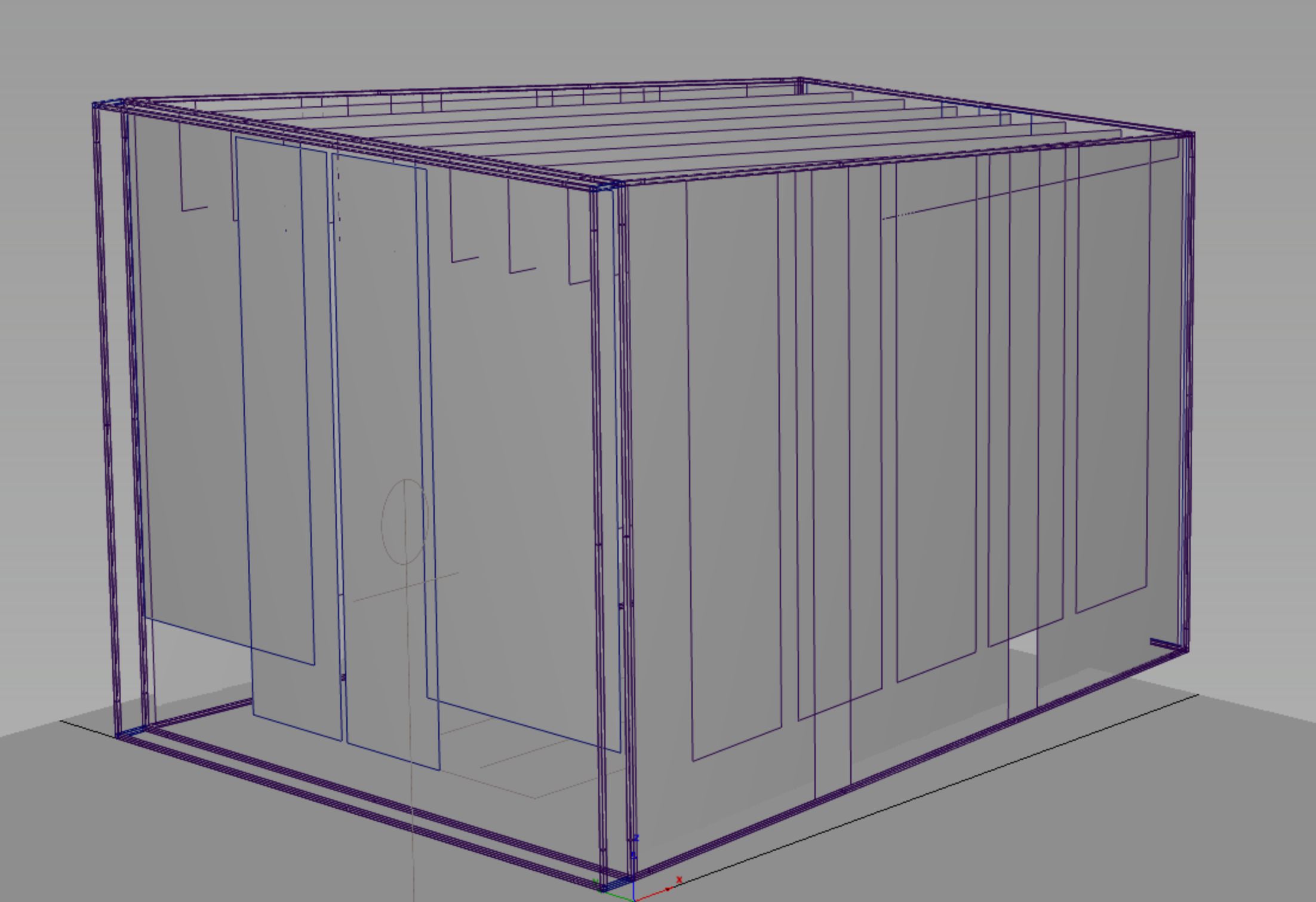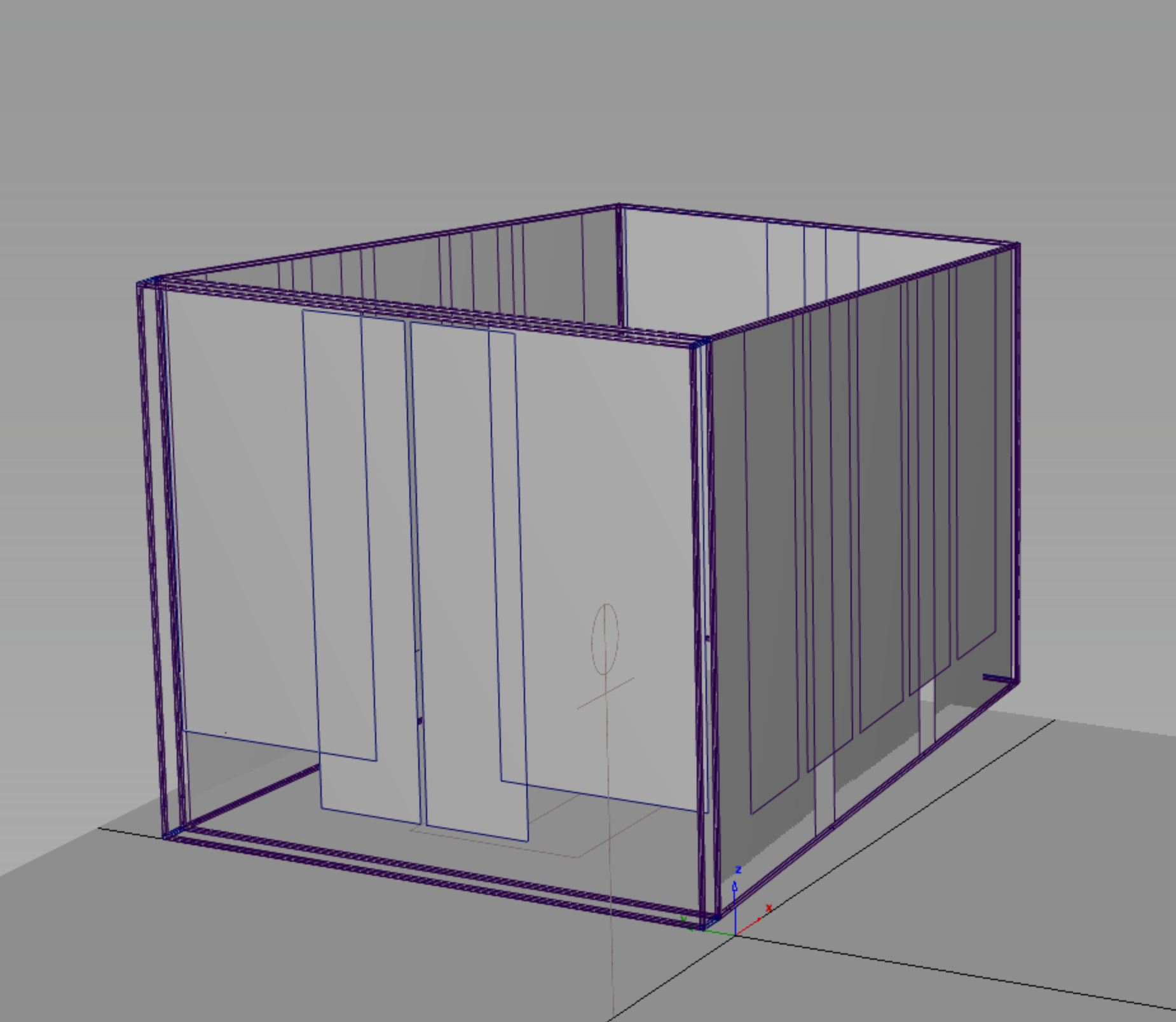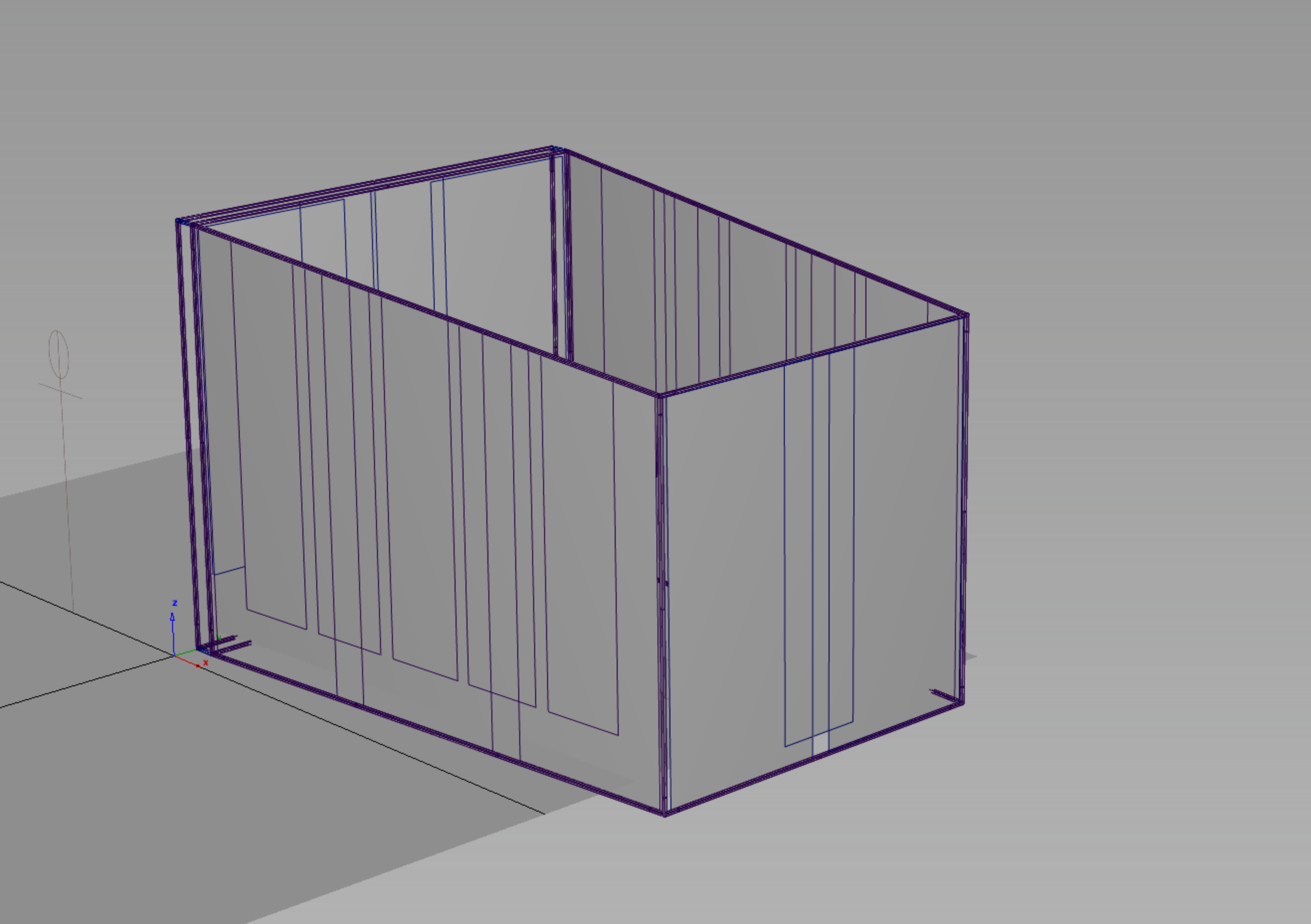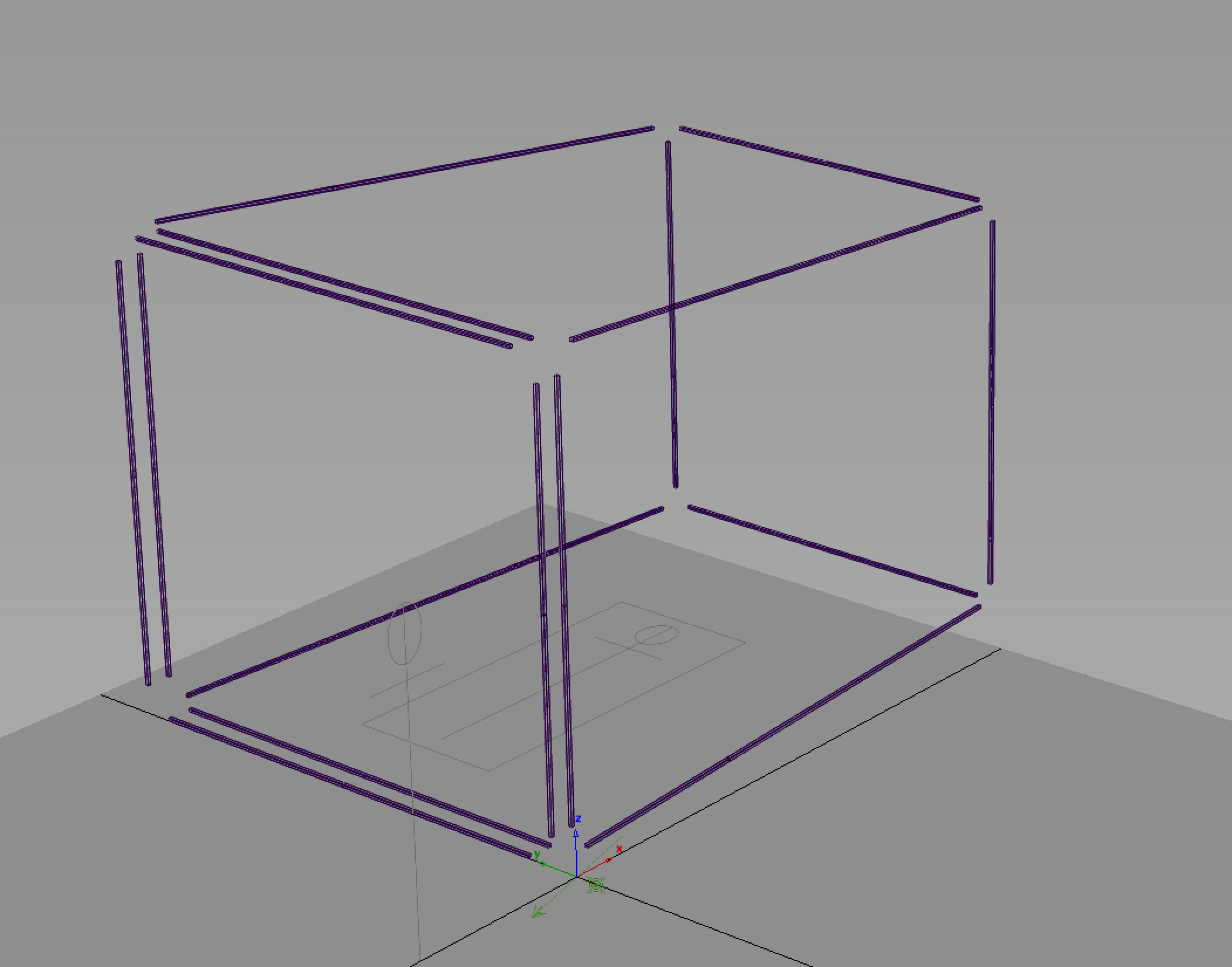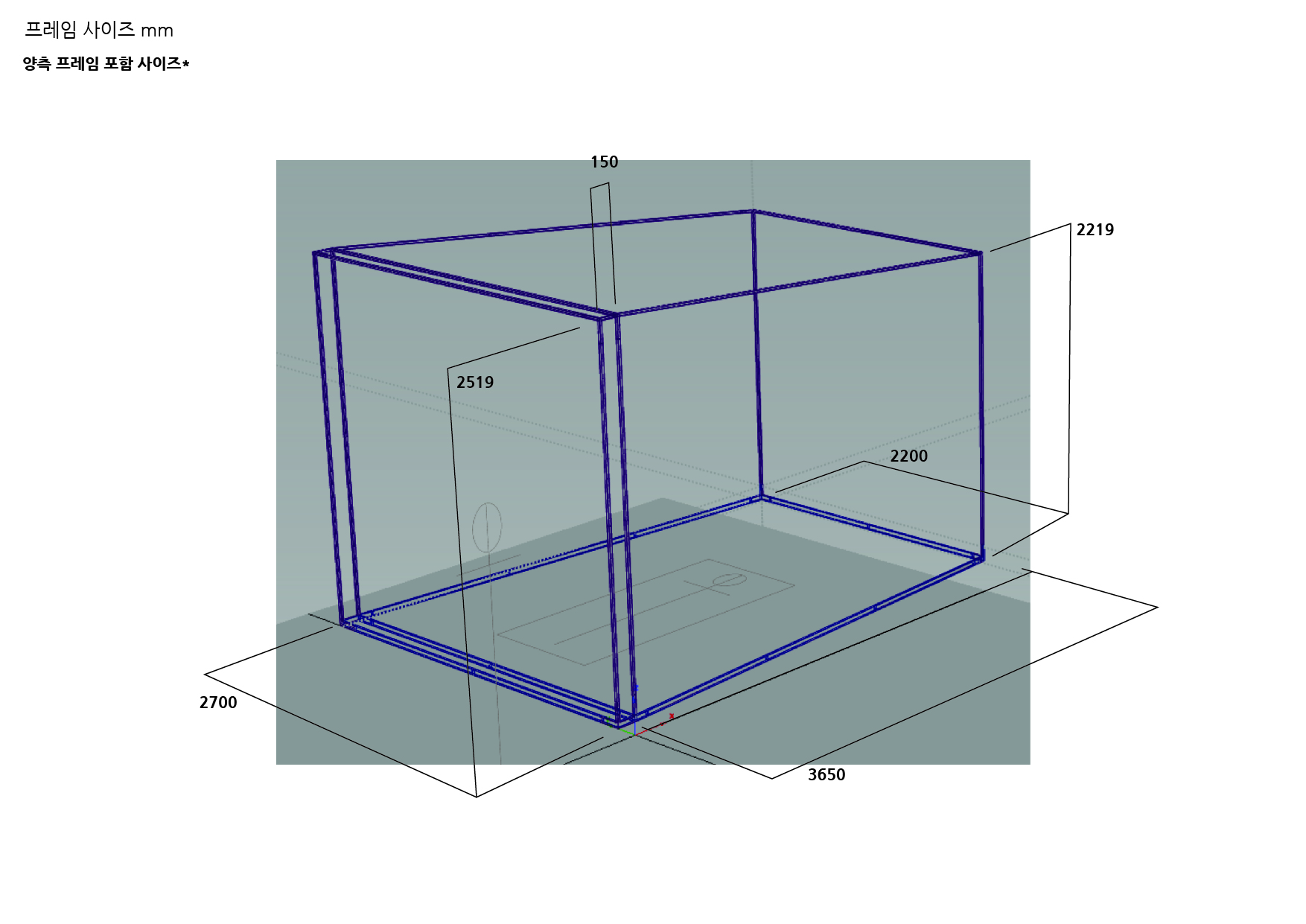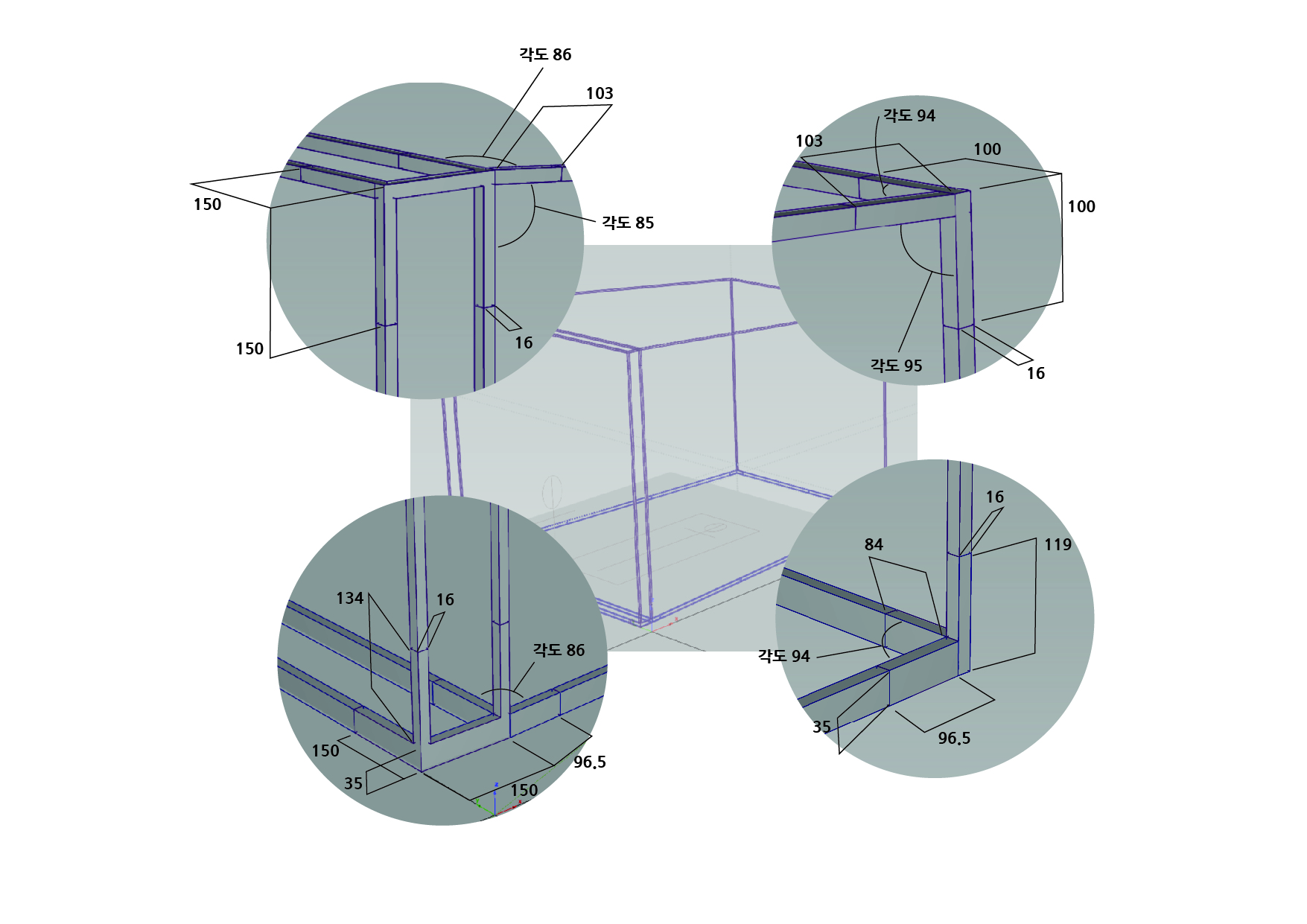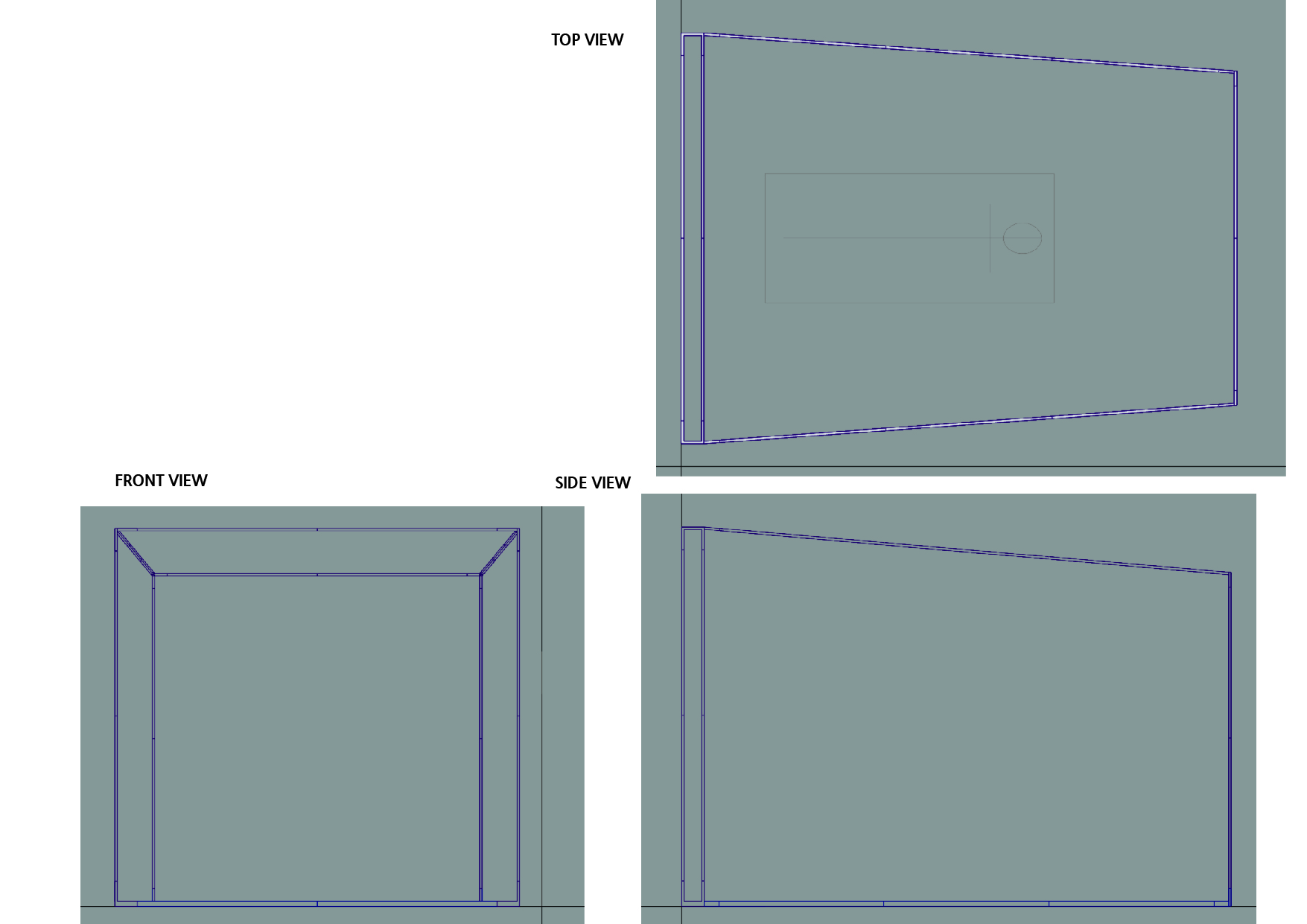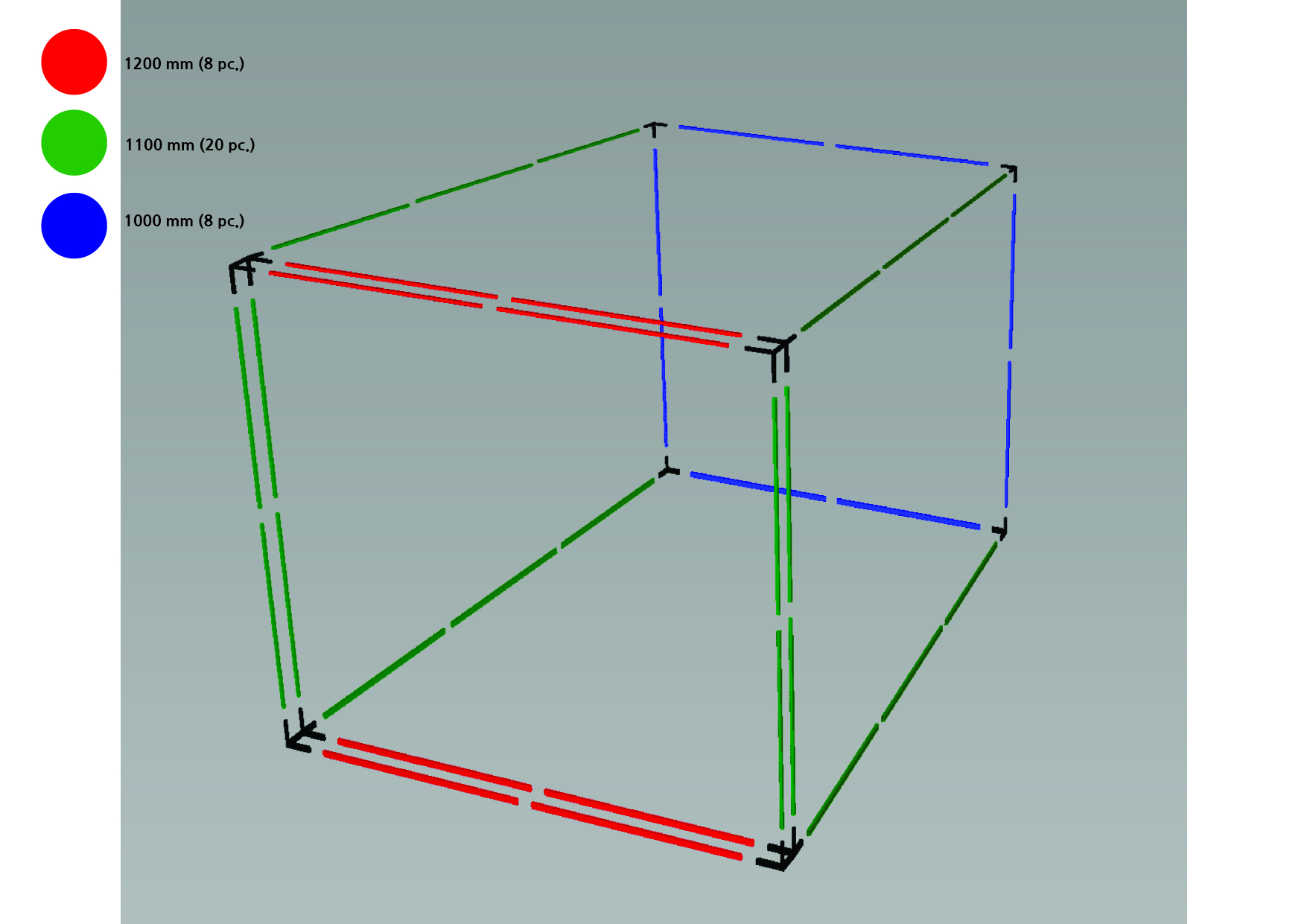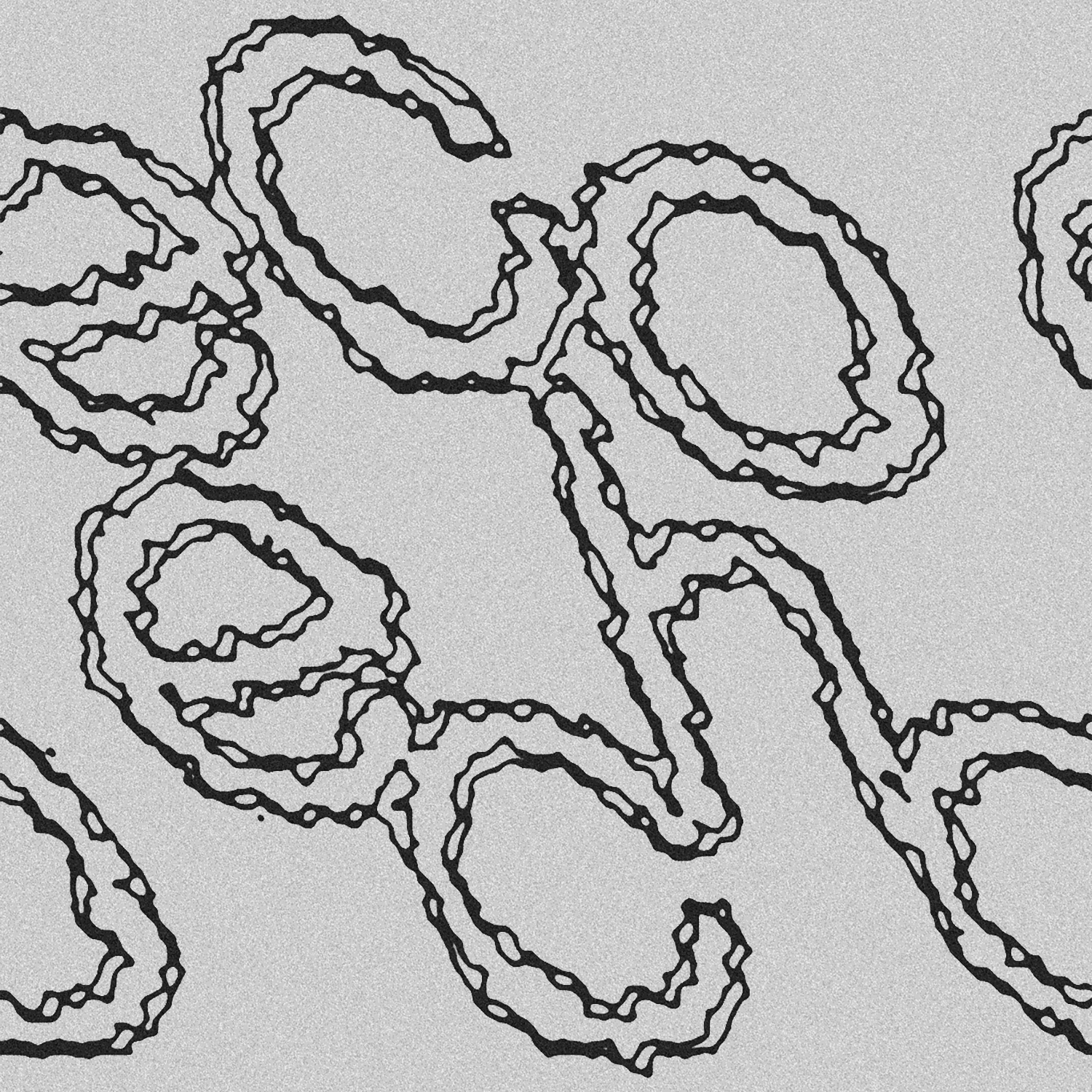
<eco - echo>
1. Budding
2. Bird, Tweet!
3. Gi-Doong
4. Spume
All tracks composed and played by 조선아
Recorded by GBRO STUDIO
Mixed & Mastered by 이건민
Recording Assistant by 서예원
Management by 배상희
Artwork by 김형도
☞Youtube Music
☞Spotify
☞Apple Music
1. Budding
2. Bird, Tweet!
3. Gi-Doong
4. Spume
All tracks composed and played by 조선아
Recorded by GBRO STUDIO
Mixed & Mastered by 이건민
Recording Assistant by 서예원
Management by 배상희
Artwork by 김형도
☞Youtube Music
☞Spotify
☞Apple Music
sound installation&performance
WayuSansu (臥遊山水)
2025
25.01.11─12
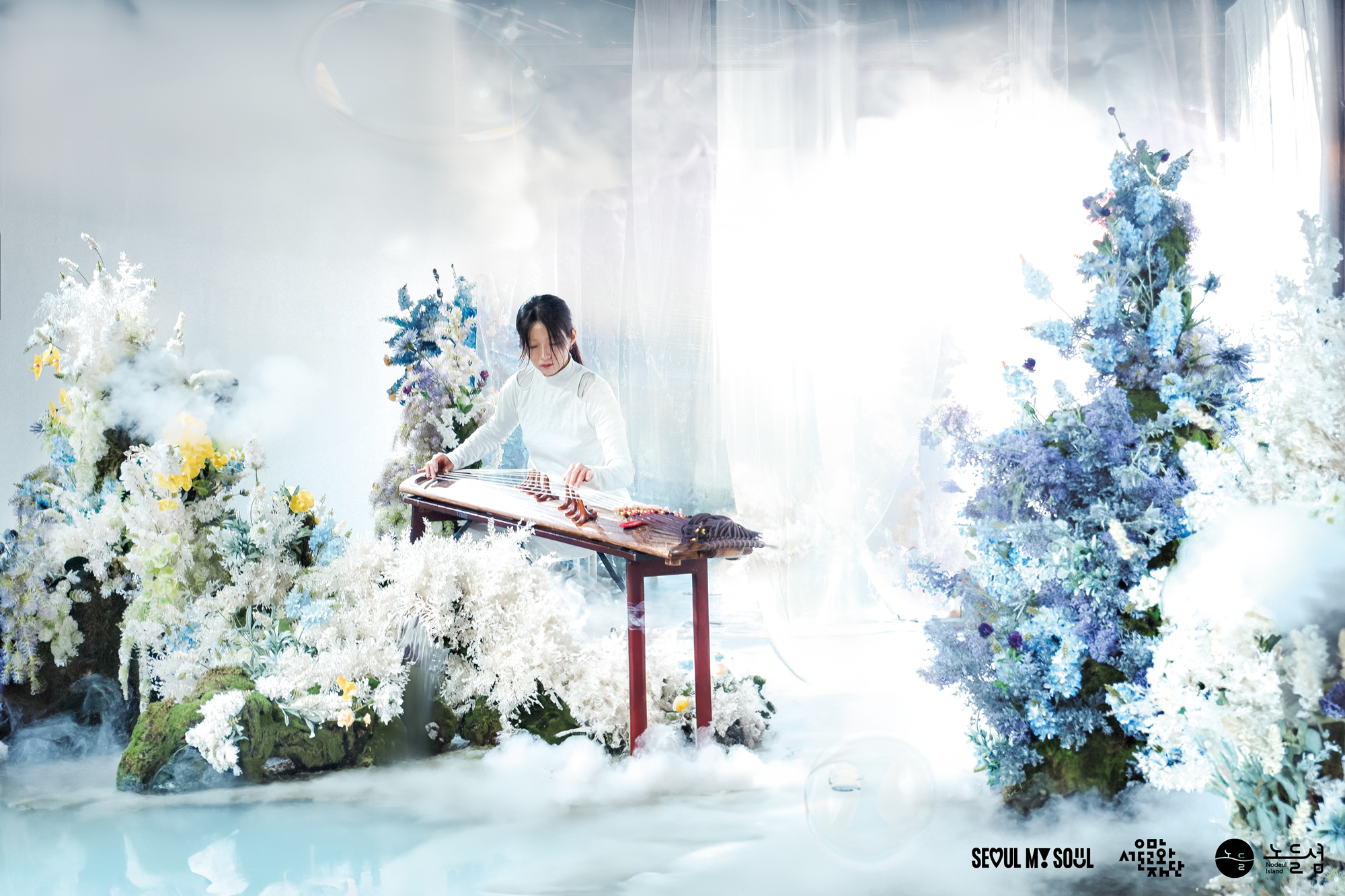
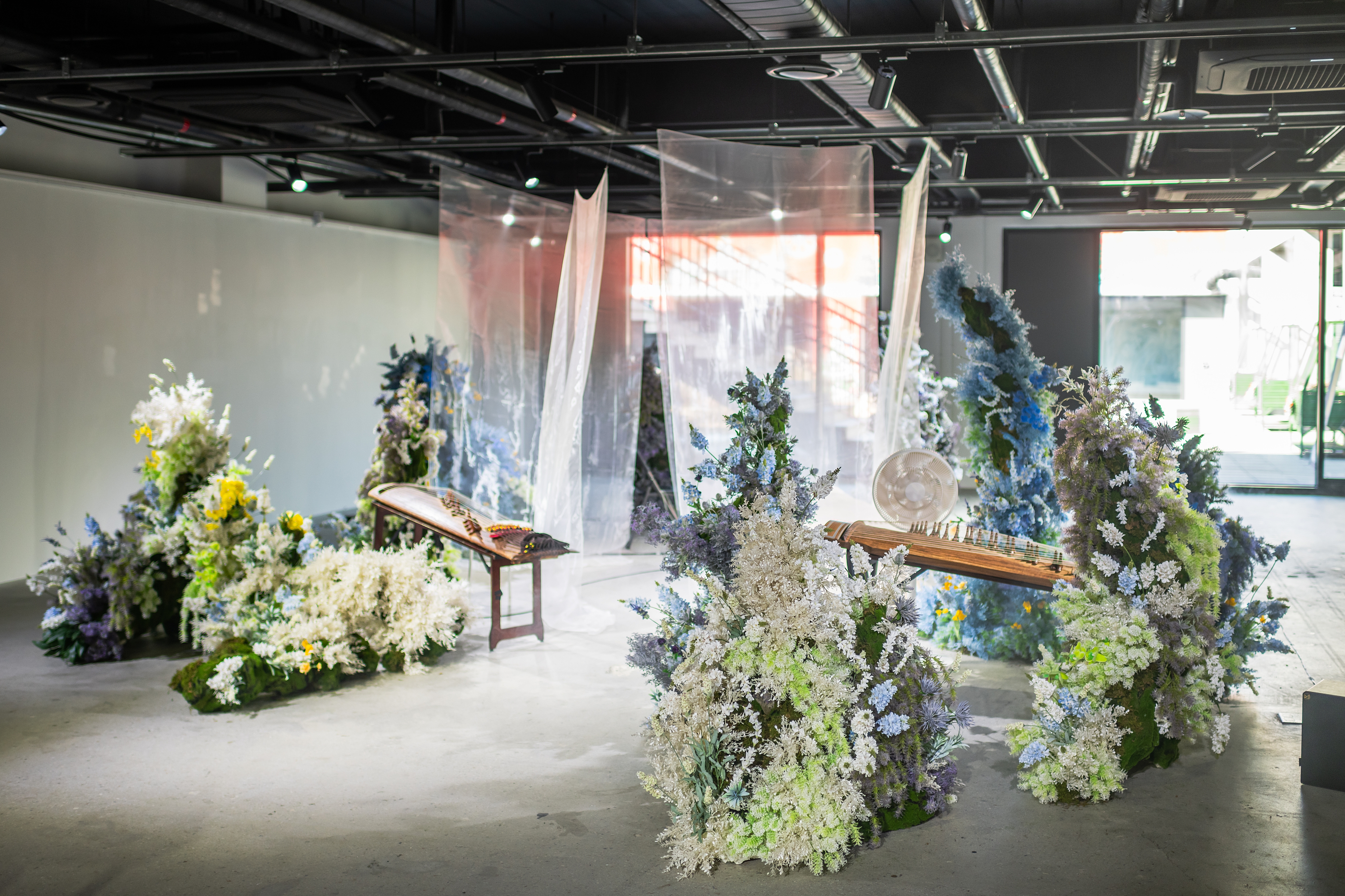
【Wind, Flow, Body】
The Korean word pungnyu (風流), often translated as “elegant enjoyment” or “poetic flow,” is frequently associated with music—perhaps because the intangible, elusive nature of sound resembles that of the wind. In Baram-san (Wind Mountain)(1), where inhalations and exhalations of wind are active and constant, sounds emerge from the gayageum through the body of the performer, flowing like wind or water. Like an egret hopping over river stones under fluttering willows, the audience is invited to lie down in the metaphorical landscape of Baram-san and experience a moment of suspended time—a dreamlike journey through imagined scenery.
(1) Baram-san is a hill located in Seodaemun-gu, Seoul, where the 2022 outdoor exhibition “Singmul” was held. In this Nodul Island exhibition, it is reimagined as a surreal spacetime drawn from the poetic universe of pungnyu.
It is a soundscape installation in which the sound of the gayageum is resonated by the wind from an electric fan, accompanied by field recordings collected by the artist. Visitors are invited to lie down and spend time in a reclining space designed for one person, installed within the exhibition venue. A two-day performance in connection with the exhibition will be held on 11th and 12th.
[Momentary Stillness]
“The origin of music is Heaven; it is granted to humankind, emerging from emptiness and completed through nature…” —From the first sentence of Akhak Gwebeom, a 15th-century Korean music treatise. In East Asian philosophy, music is not composed by humans but arises from the breath of the cosmos. Sound is already present in the universe—it flows into the world through the living body.
In this piece, the artist becomes a medium through which the sound of the gayageum unfolds. The flowing sonic currents, like wind or water, are briefly caught and unfurled. These ephemeral vibrations fade quickly into silence, just as the wind ultimately ceases. Through gayageum, the artist does not seek to “compose” in a Western sense but to momentarily select from an infinite field of cosmic resonance. The act of pausing in the middle of constant flow to listen to space and sound is a methodology for composition—and also a way to truly inhabit the present.
Duration: 120 minutes
Performances: 4 times
Medium: Traditional improvised playing techniques, field recording, installation
Nodeul Island, Seoul
Concept, installation, Improvisation, Sound design
☞youtube
“Developed for the group exhibition Breath: Garden of Respiration, with contribution to the curatorial concept”
【흐르는 바람에 몸을 뉘어】
흔히 풍류(風流)는 음악에 비유되곤 하는데, 보이거나 잡히지 않는 소리의 물성이 바람과 비슷하기 때문일지도 모른다. 들숨과 날숨이 활발히 일어나고 있는 바람산(1). 연주자의 몸을 통과해 가야금 줄을 튕겨 나오는 소리들은 바람처럼, 혹은 강물처럼 흐르고 있다. 버드나무가 흐드러진 강변에서 징검돌을 밟으며 노닐던 백로처럼―바람산에 누워 시간이 멈춘 산수(山水)를 유람하는 와유((臥遊)의 방식을 제안한다.
(1) 2022년 전시 [싱물]의 장소로 서울 서대문구에 위치한 산이다. 이번 노들섬 전시에서는 풍류세계에서 묘사되는 초현실적인 시공간으로 설정했다.
선풍기 바람이 가야금을 울려 나는 소리와 작가가 채집한 필드레코딩 사운드가 재생되는 사운드스케이프 전시입니다. 전시 공간에 설치된 1인을 위한 와유공간에 누워 시간을 보낼 수 있습니다. 11일─12일 이틀간 전시 연계 퍼포먼스가 진행됩니다.
【찰나의 고요】
“음악은 하늘에서 나와서 사람에게 붙인 것이요, 공허한 데서 출발하여 자연에서 이루어지는 것이니…“ 악학궤범의 첫 문장이다. 동양에서 음악은 사람이 작곡하는 것이 아닌, 우주에 이미 존재하는 음향이 숨쉬는 몸을 통해 나오는 것이다. 작가는 살아있는 바람, 혹은 물이 되어 가야금을 흐르는 소리들을 붙잡아 늘어놓는다. 놓여진 소리들은 금세 울림이 멎어 사라진다. 바람이 되어 끝내 멈춘다.
작가는 가야금을 통해 소리를 나열하는 매개자가 됩니다. 무한히 흐르는 우주의 음향 속에서 찰나의 멈춤을 고르는 일은 작가가 곡을 만드는 방법론이기도 합니다. 흐르는 순간 속에 잠시 멈춰 공간의 음향을 들어보는 것, 현재에 존재하는 방법 중 하나입니다.
120분
4회
전통 어법의 즉흥 연주, 필드레코딩, 설치
노들섬 노들갤러리 2관
기획·설치·연주·사운드
☞youtube
그룹전 <숨:호흡의 정원>에 기획참여하여 만든 전시입니다.
The Korean word pungnyu (風流), often translated as “elegant enjoyment” or “poetic flow,” is frequently associated with music—perhaps because the intangible, elusive nature of sound resembles that of the wind. In Baram-san (Wind Mountain)(1), where inhalations and exhalations of wind are active and constant, sounds emerge from the gayageum through the body of the performer, flowing like wind or water. Like an egret hopping over river stones under fluttering willows, the audience is invited to lie down in the metaphorical landscape of Baram-san and experience a moment of suspended time—a dreamlike journey through imagined scenery.
(1) Baram-san is a hill located in Seodaemun-gu, Seoul, where the 2022 outdoor exhibition “Singmul” was held. In this Nodul Island exhibition, it is reimagined as a surreal spacetime drawn from the poetic universe of pungnyu.
It is a soundscape installation in which the sound of the gayageum is resonated by the wind from an electric fan, accompanied by field recordings collected by the artist. Visitors are invited to lie down and spend time in a reclining space designed for one person, installed within the exhibition venue. A two-day performance in connection with the exhibition will be held on 11th and 12th.
[Momentary Stillness]
“The origin of music is Heaven; it is granted to humankind, emerging from emptiness and completed through nature…” —From the first sentence of Akhak Gwebeom, a 15th-century Korean music treatise. In East Asian philosophy, music is not composed by humans but arises from the breath of the cosmos. Sound is already present in the universe—it flows into the world through the living body.
In this piece, the artist becomes a medium through which the sound of the gayageum unfolds. The flowing sonic currents, like wind or water, are briefly caught and unfurled. These ephemeral vibrations fade quickly into silence, just as the wind ultimately ceases. Through gayageum, the artist does not seek to “compose” in a Western sense but to momentarily select from an infinite field of cosmic resonance. The act of pausing in the middle of constant flow to listen to space and sound is a methodology for composition—and also a way to truly inhabit the present.
Duration: 120 minutes
Performances: 4 times
Medium: Traditional improvised playing techniques, field recording, installation
Nodeul Island, Seoul
Concept, installation, Improvisation, Sound design
☞youtube
“Developed for the group exhibition Breath: Garden of Respiration, with contribution to the curatorial concept”
【흐르는 바람에 몸을 뉘어】
흔히 풍류(風流)는 음악에 비유되곤 하는데, 보이거나 잡히지 않는 소리의 물성이 바람과 비슷하기 때문일지도 모른다. 들숨과 날숨이 활발히 일어나고 있는 바람산(1). 연주자의 몸을 통과해 가야금 줄을 튕겨 나오는 소리들은 바람처럼, 혹은 강물처럼 흐르고 있다. 버드나무가 흐드러진 강변에서 징검돌을 밟으며 노닐던 백로처럼―바람산에 누워 시간이 멈춘 산수(山水)를 유람하는 와유((臥遊)의 방식을 제안한다.
(1) 2022년 전시 [싱물]의 장소로 서울 서대문구에 위치한 산이다. 이번 노들섬 전시에서는 풍류세계에서 묘사되는 초현실적인 시공간으로 설정했다.
선풍기 바람이 가야금을 울려 나는 소리와 작가가 채집한 필드레코딩 사운드가 재생되는 사운드스케이프 전시입니다. 전시 공간에 설치된 1인을 위한 와유공간에 누워 시간을 보낼 수 있습니다. 11일─12일 이틀간 전시 연계 퍼포먼스가 진행됩니다.
【찰나의 고요】
“음악은 하늘에서 나와서 사람에게 붙인 것이요, 공허한 데서 출발하여 자연에서 이루어지는 것이니…“ 악학궤범의 첫 문장이다. 동양에서 음악은 사람이 작곡하는 것이 아닌, 우주에 이미 존재하는 음향이 숨쉬는 몸을 통해 나오는 것이다. 작가는 살아있는 바람, 혹은 물이 되어 가야금을 흐르는 소리들을 붙잡아 늘어놓는다. 놓여진 소리들은 금세 울림이 멎어 사라진다. 바람이 되어 끝내 멈춘다.
작가는 가야금을 통해 소리를 나열하는 매개자가 됩니다. 무한히 흐르는 우주의 음향 속에서 찰나의 멈춤을 고르는 일은 작가가 곡을 만드는 방법론이기도 합니다. 흐르는 순간 속에 잠시 멈춰 공간의 음향을 들어보는 것, 현재에 존재하는 방법 중 하나입니다.
120분
4회
전통 어법의 즉흥 연주, 필드레코딩, 설치
노들섬 노들갤러리 2관
기획·설치·연주·사운드
☞youtube
그룹전 <숨:호흡의 정원>에 기획참여하여 만든 전시입니다.
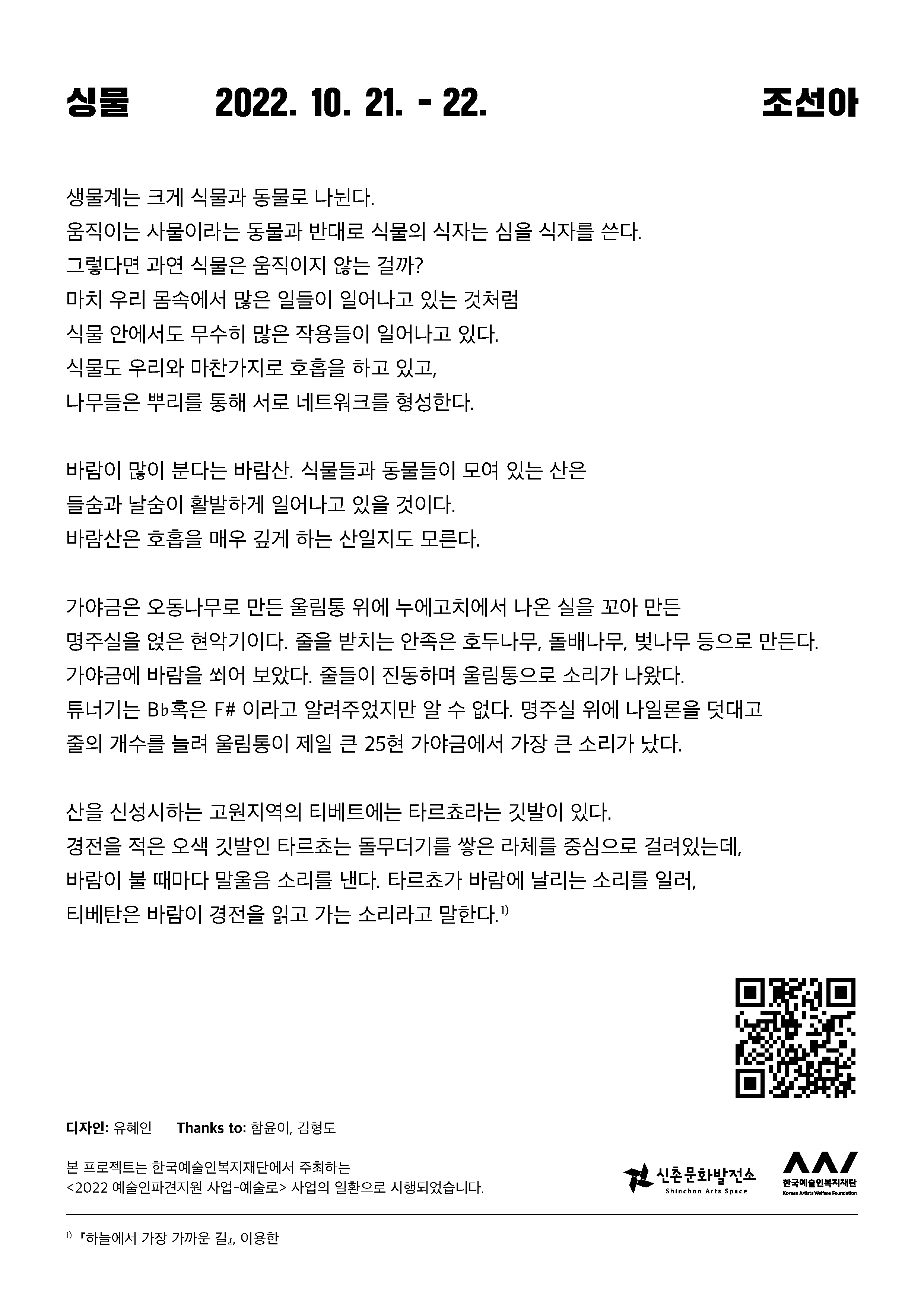
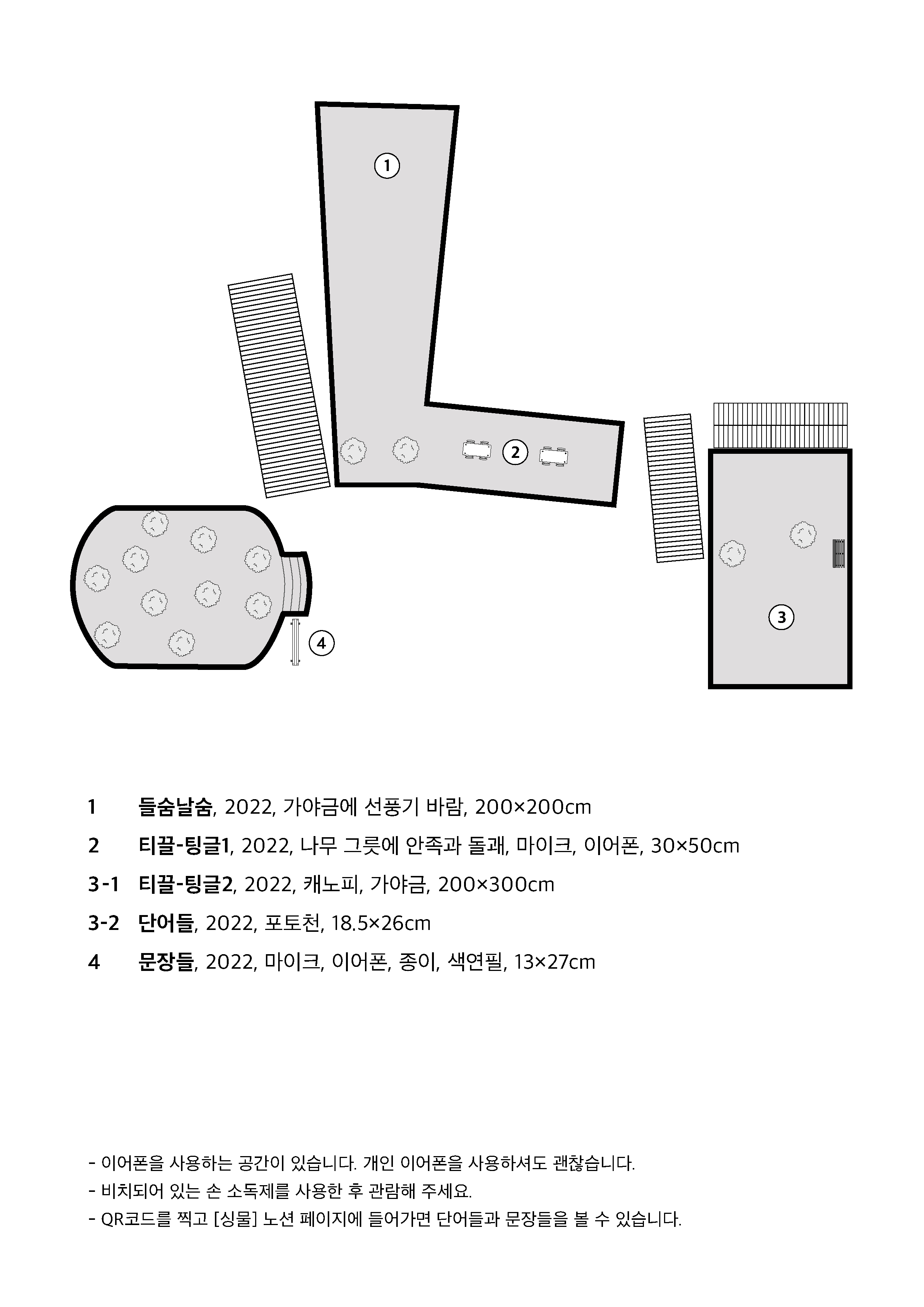
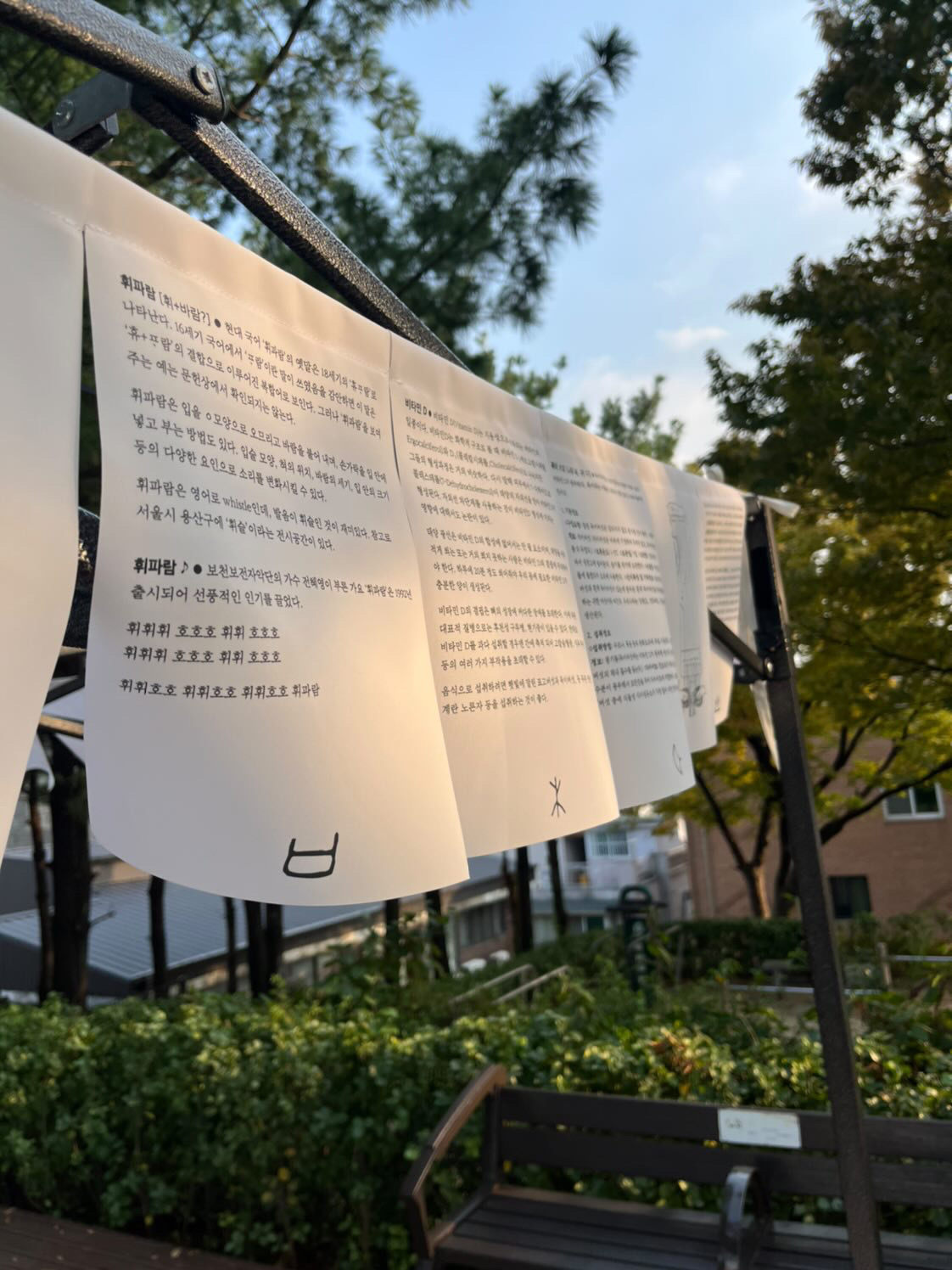
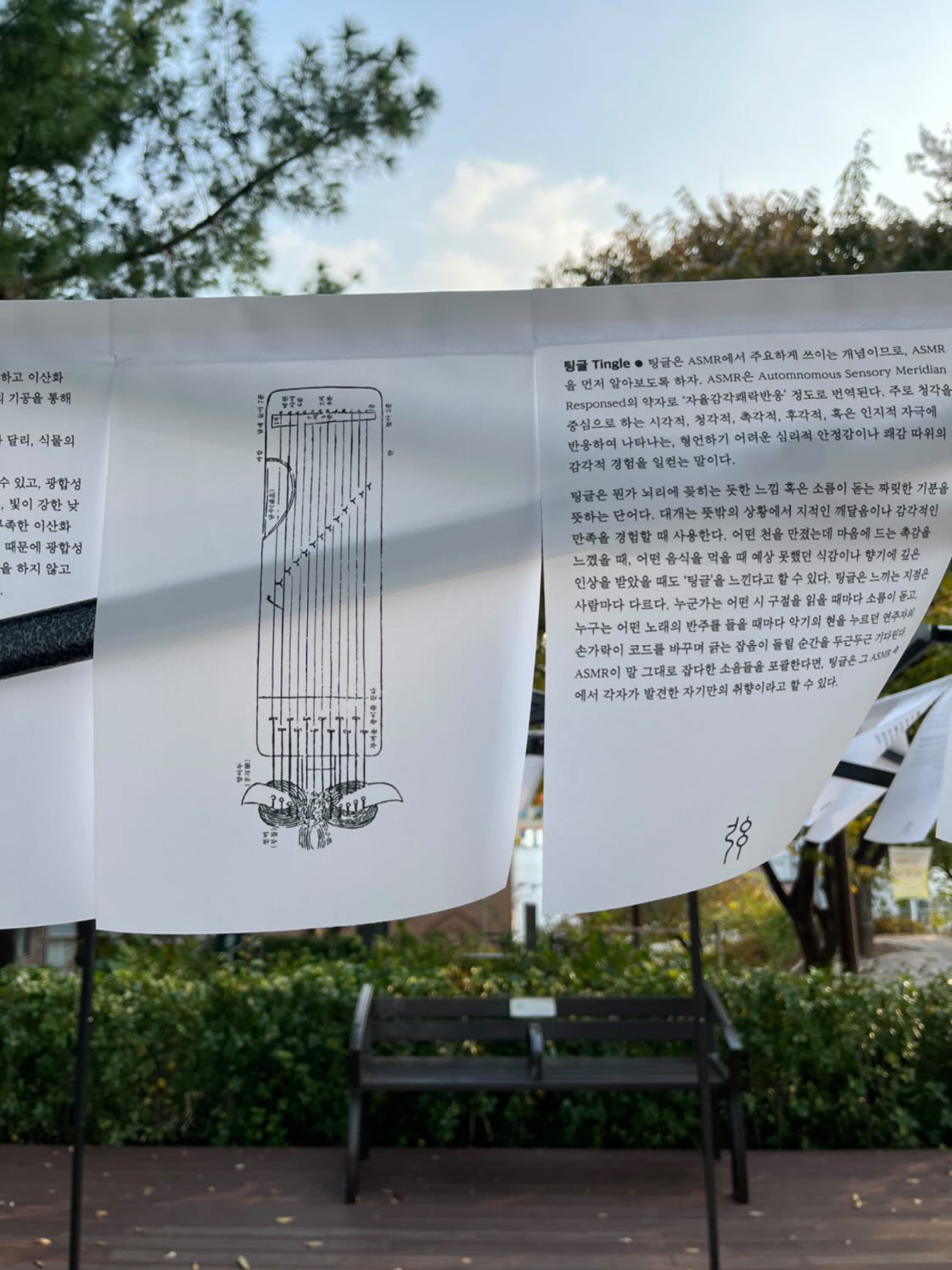
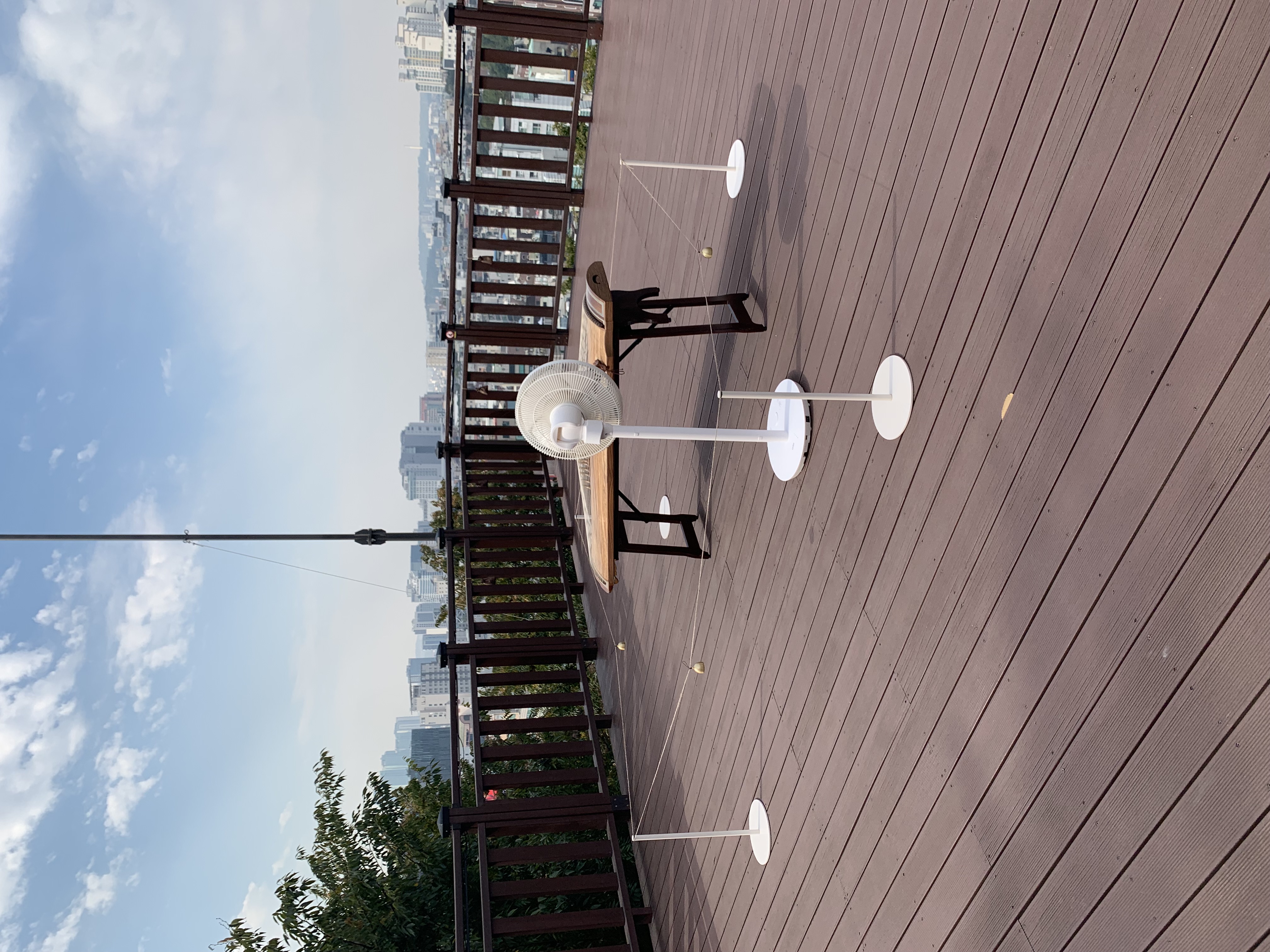
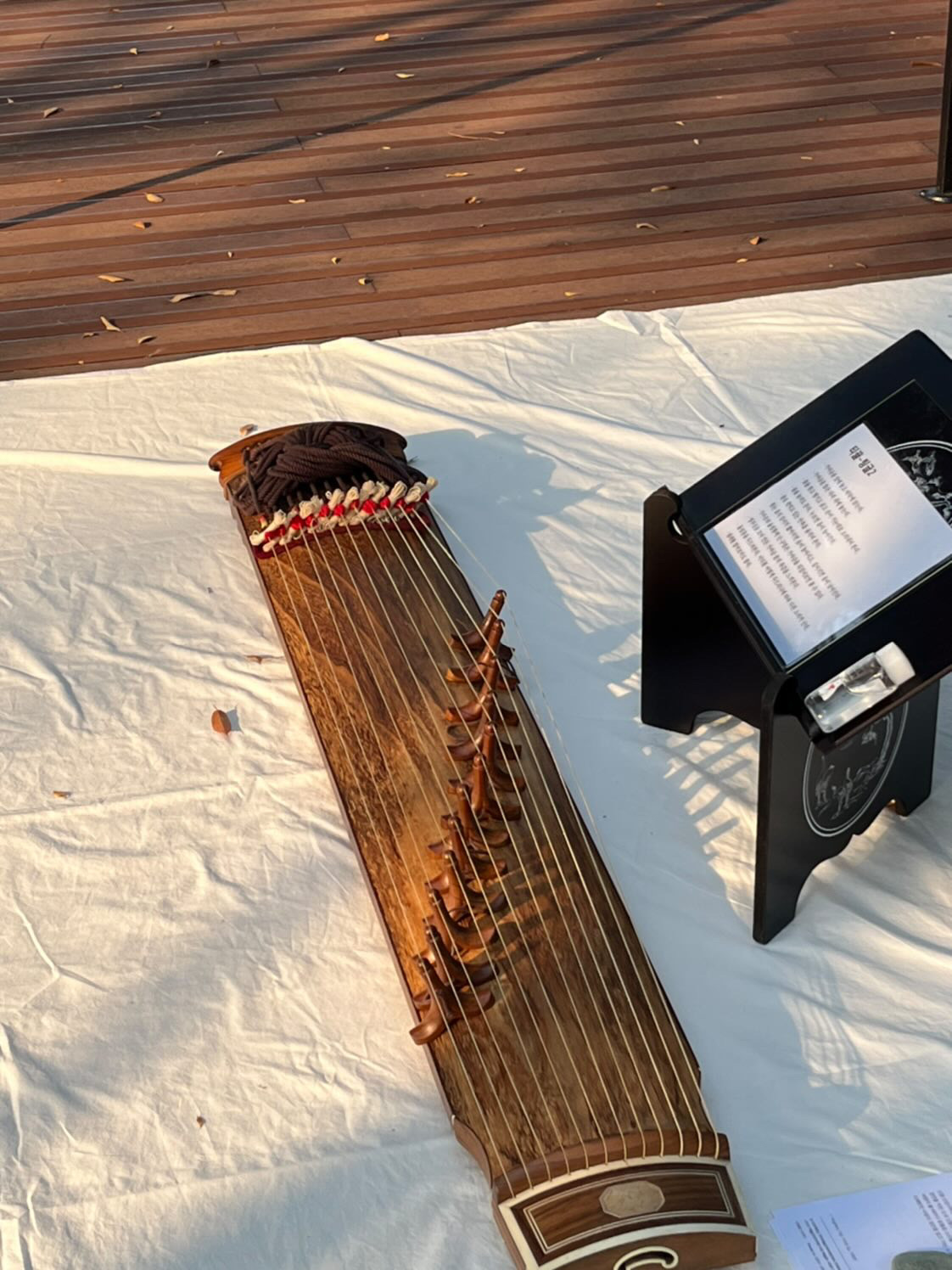
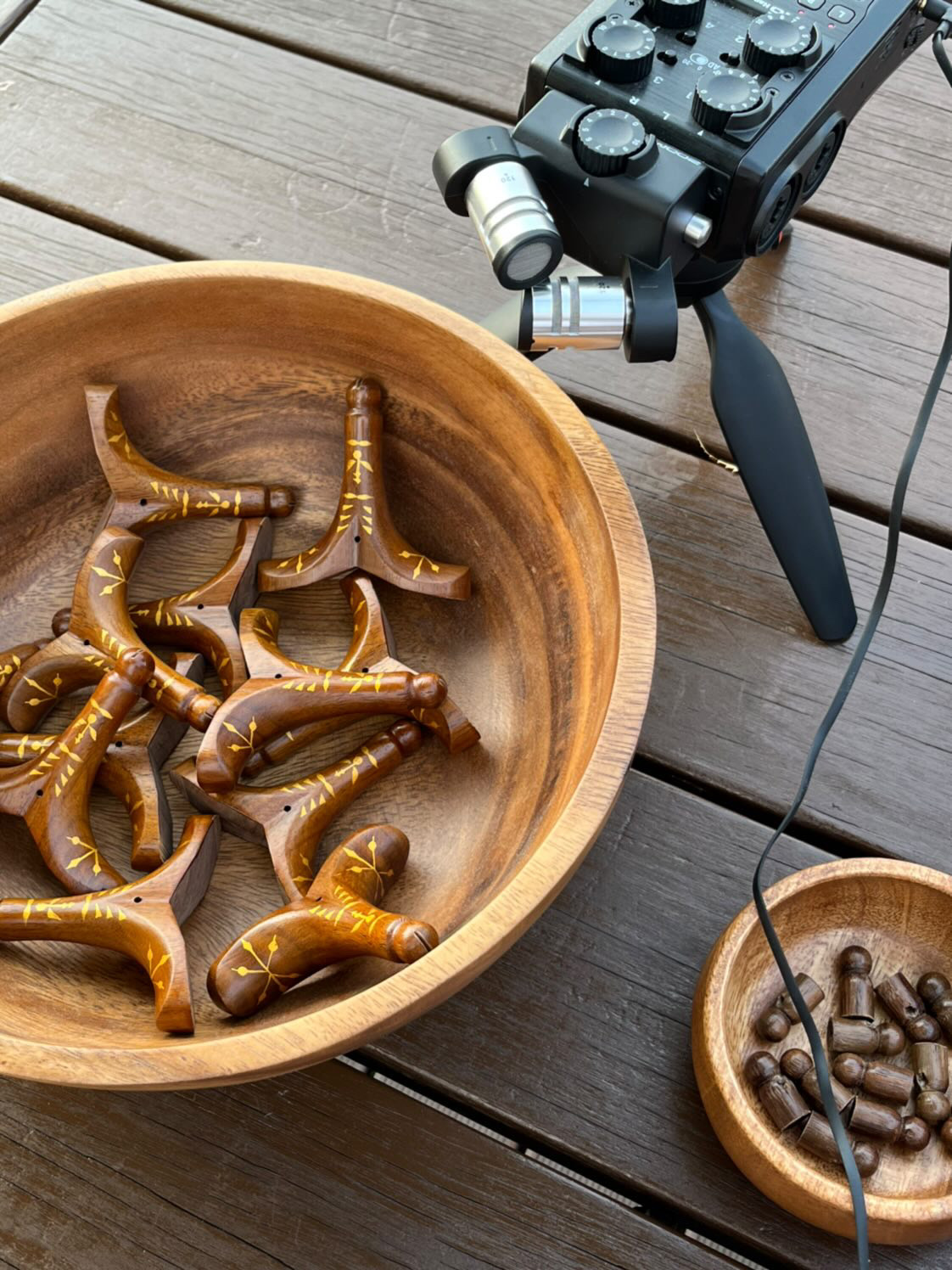
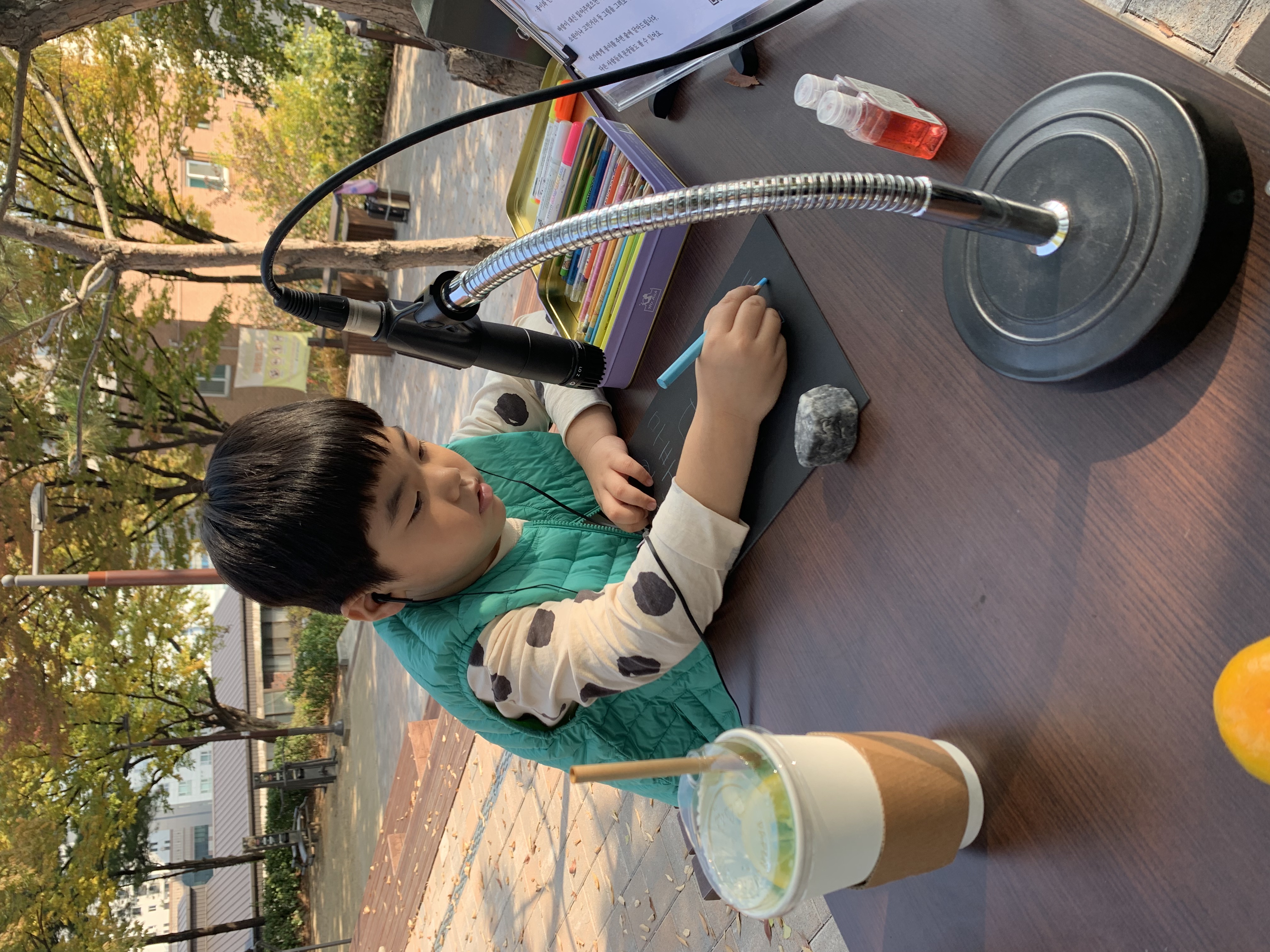
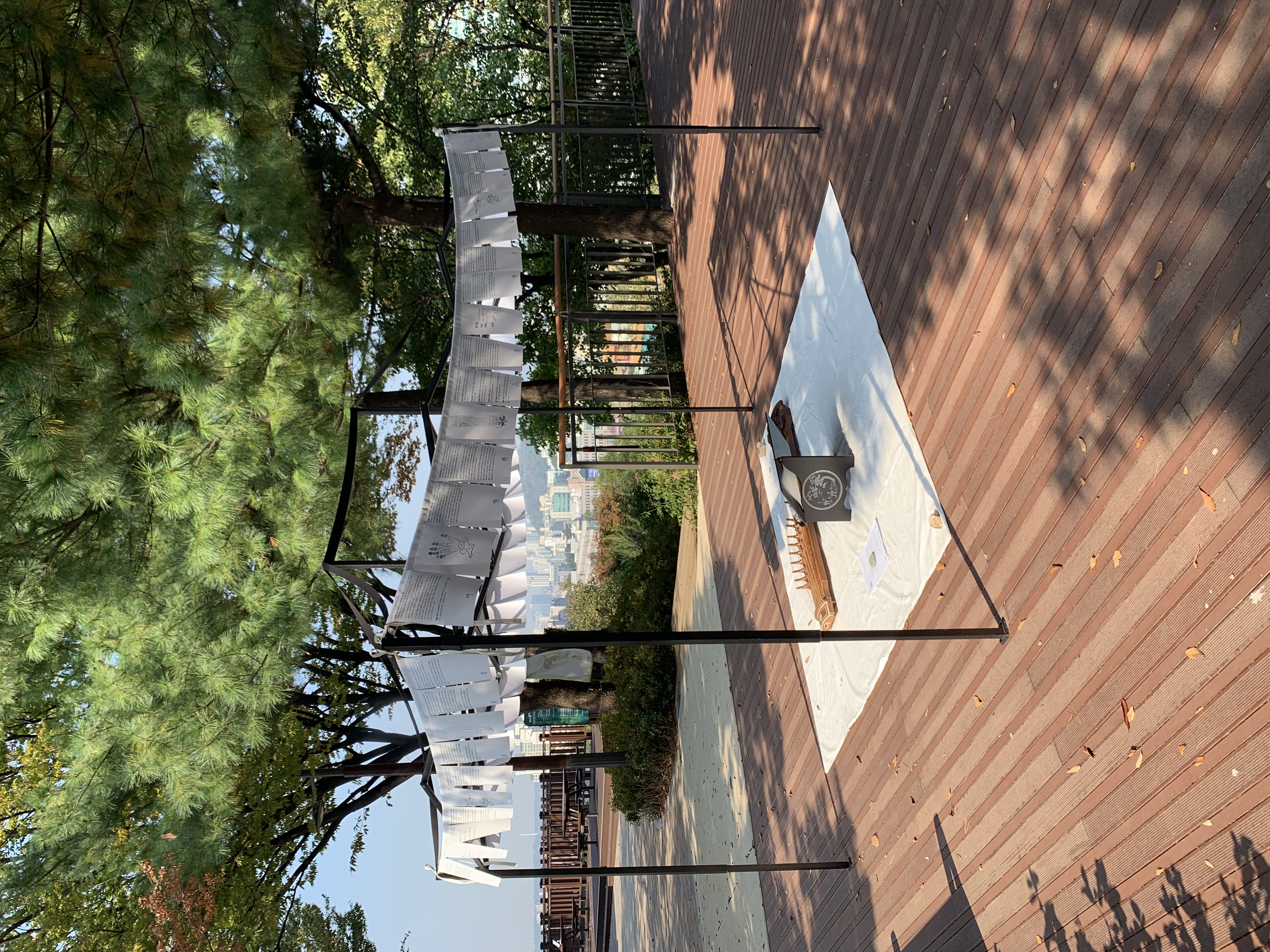
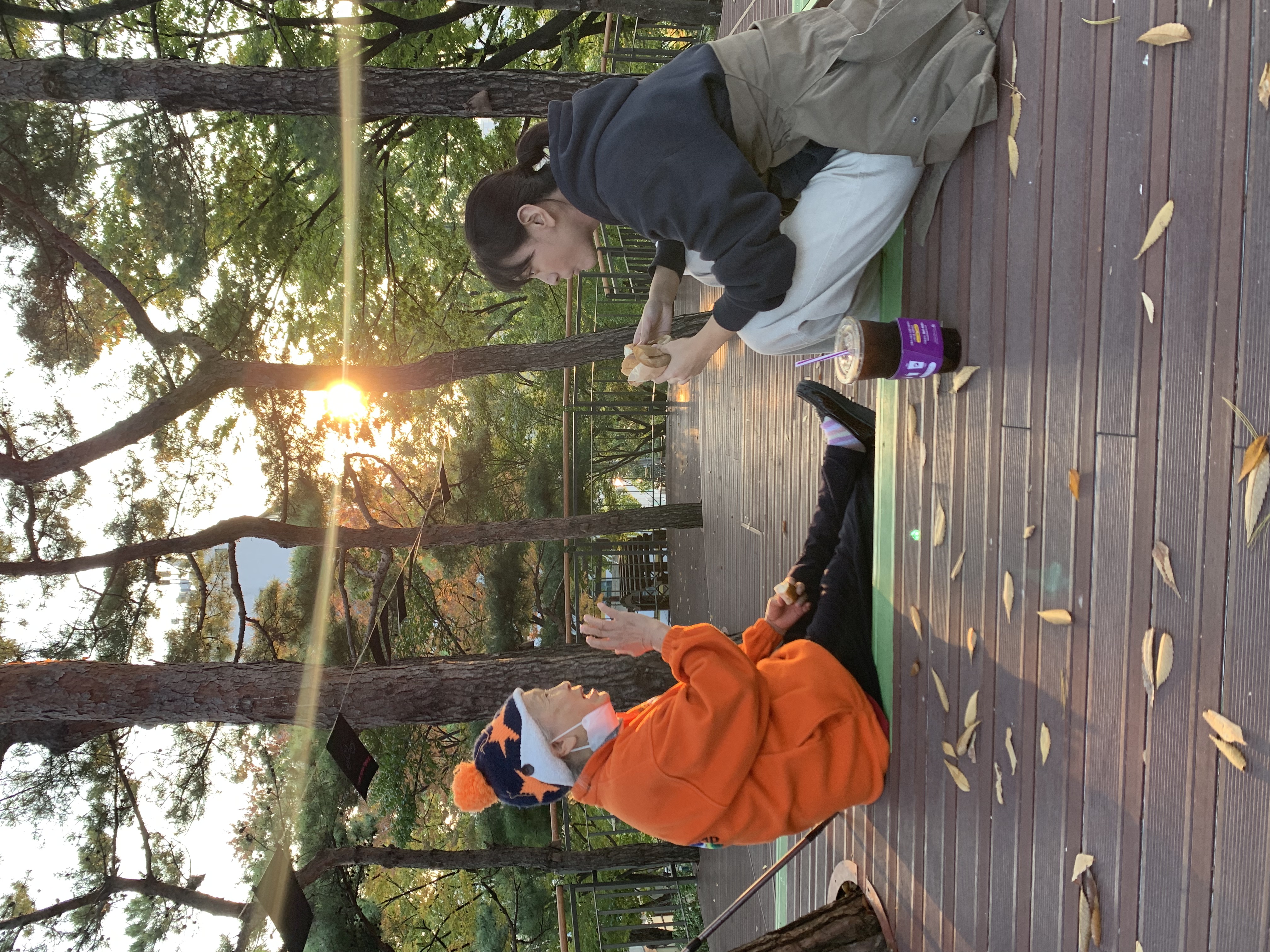
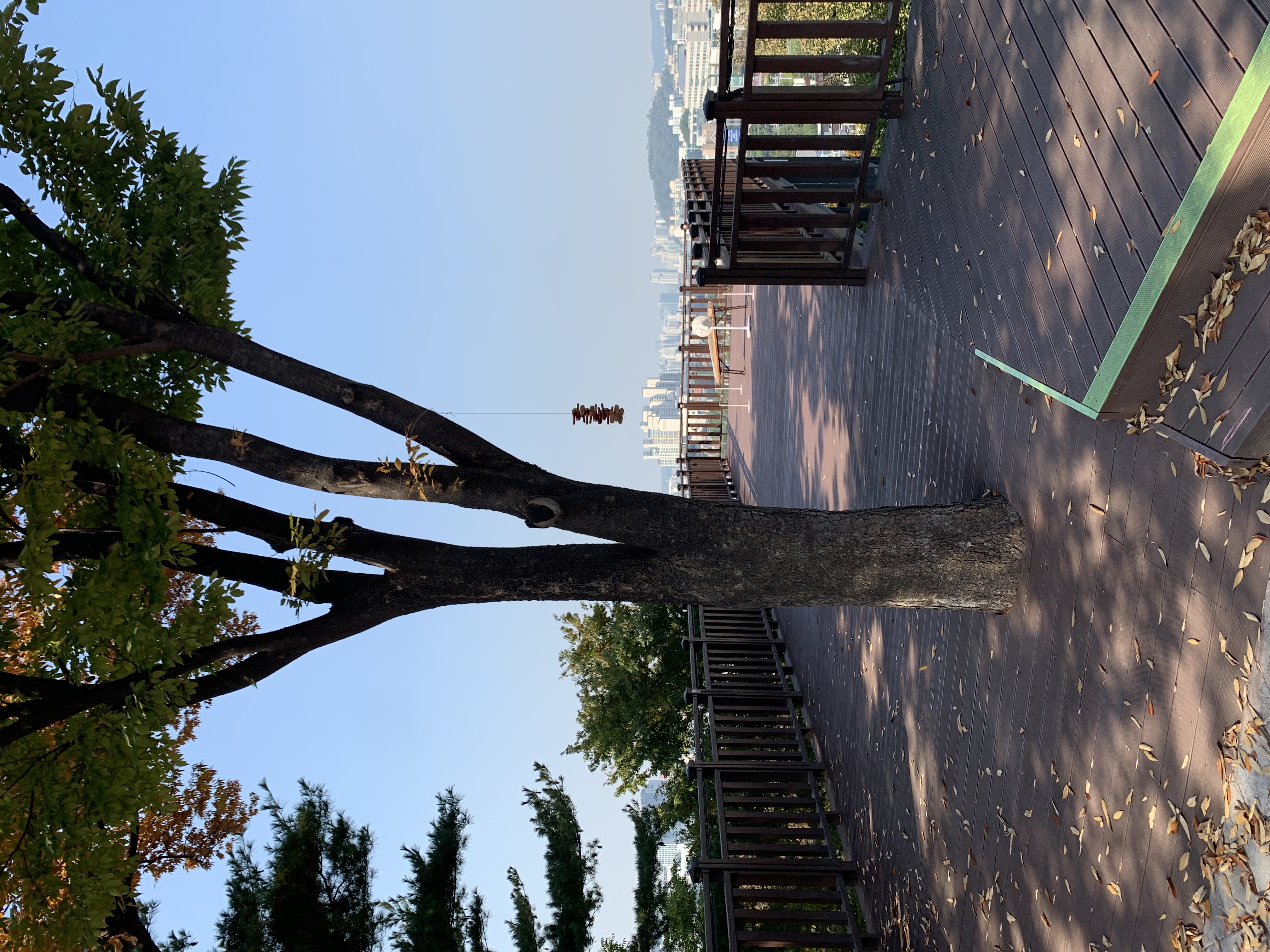
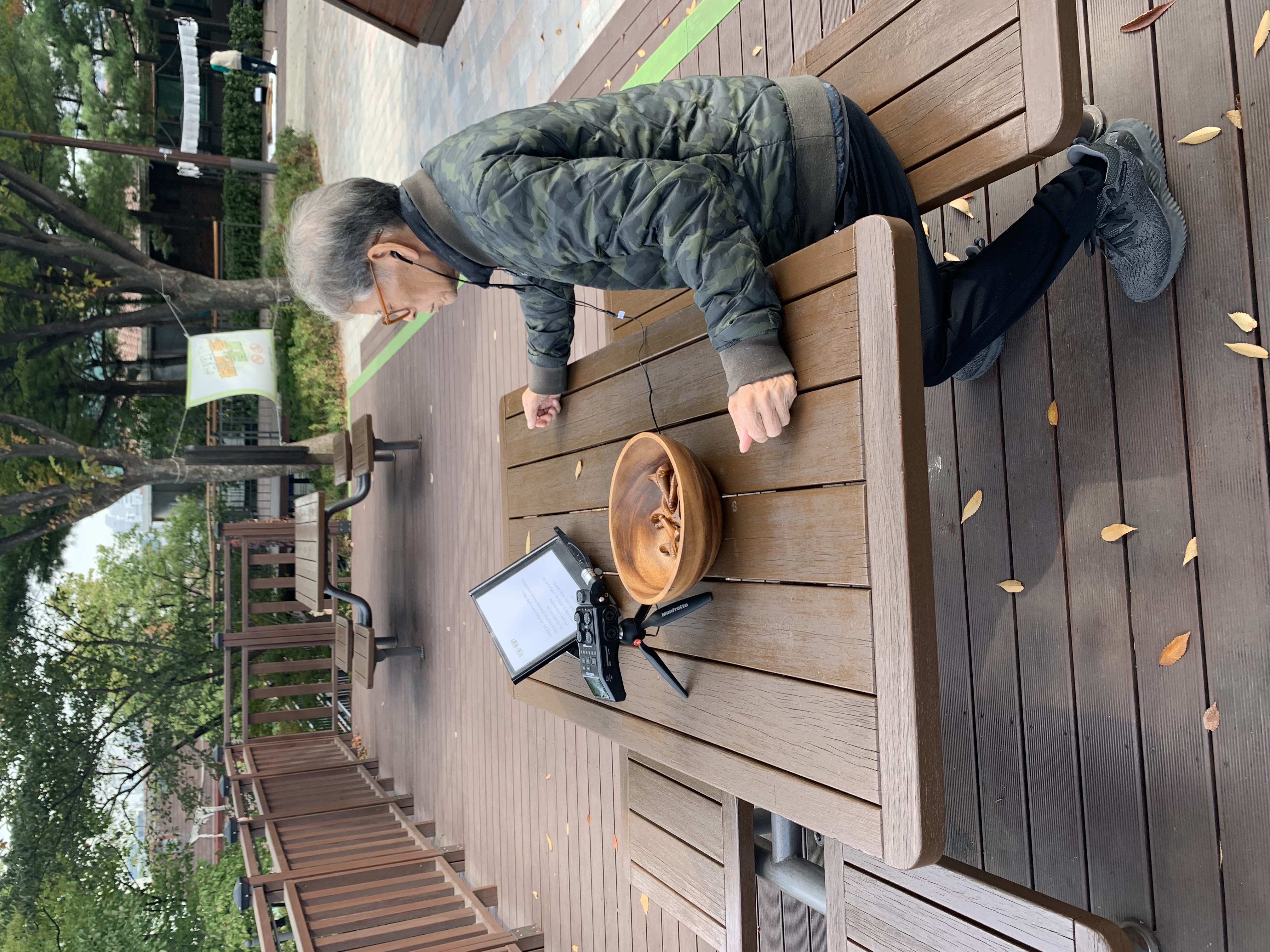
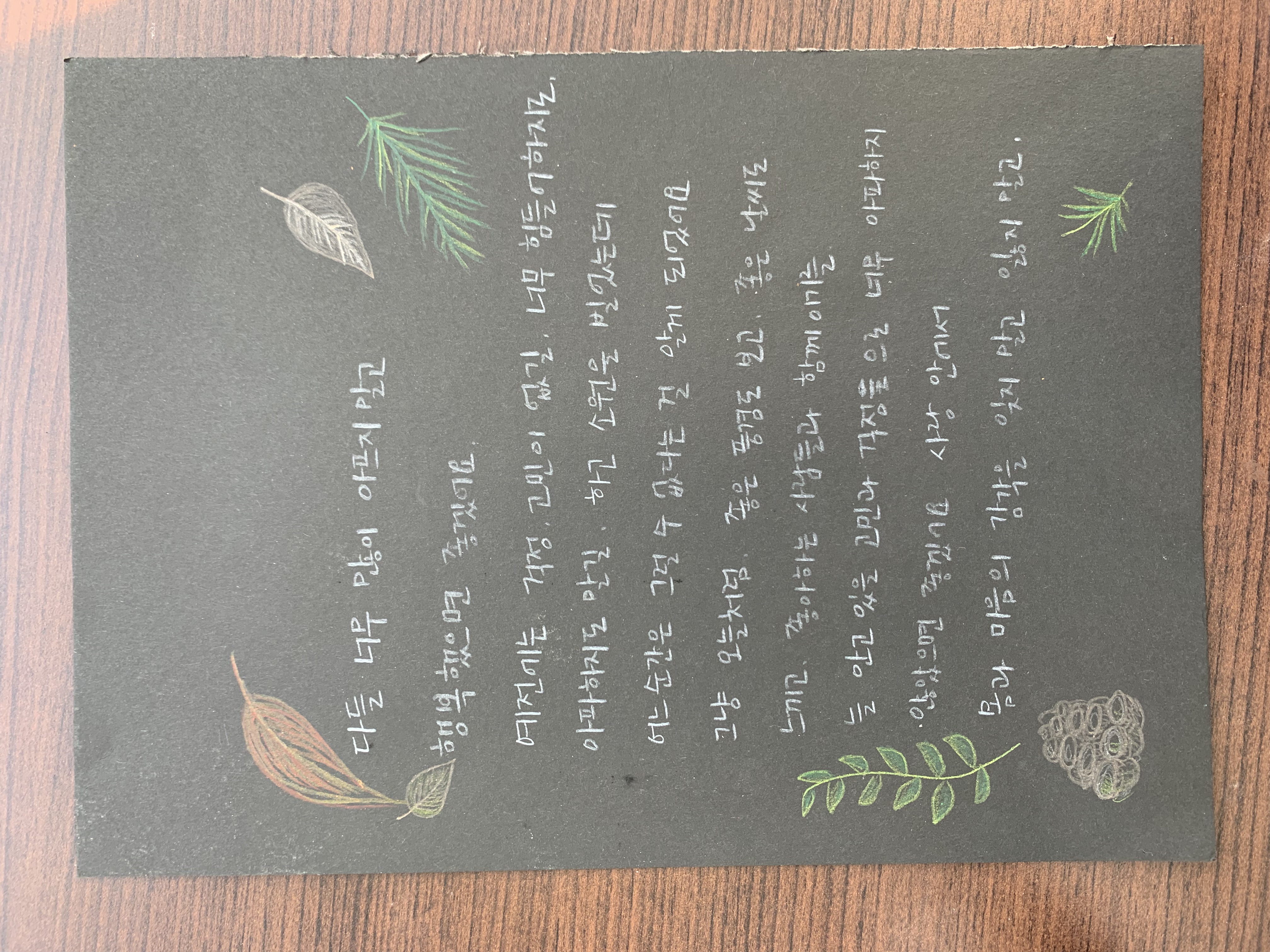
<sing-mul>
An outdoor soundscape installation created over six months of visiting Baramsan (literally “Wind Mountain”), located in Changcheon-dong, Seodaemun-gu, Seoul. Inspired by the themes of wind, mountain, and the dogs that frequent the mountain, words related to these were turned into small flag-like prayer banners (tarcho) and hung from a canopy. A gayageum was placed underneath, inviting visitors to make their own sounds with the instrument.
Viewers could also write down their wishes on paper while listening to the sound of their own writing, then turn them into tarcho and hang them up. As the tarcho gradually accumulated, they became part of the installation. On one side, a gayageum was installed to be played by the wind.
In biology, living things are divided into animals and plants. While animals are moving beings, the Chinese character for “plant” (植) means “to plant”—implying stillness. But are plants truly immobile?
Just as many unseen processes occur within our bodies, countless actions are happening inside plants. They breathe, and trees form networks through their roots.
The site, Baram Mountain (“Windy Mountain”), is a place where plants and trees gather. Inhalation and exhalation take place vividly here. Perhaps, this mountain breathes deeply.
In the Tibetan highlands, where mountains are regarded as sacred, there are prayer flags called tarcheo. These five-colored flags, inscribed with Buddhist scriptures, are often hung around lhatse—piles of stones marking sacred sites. When the wind blows, the tarcheo flutter and produce a sound resembling a horse’s neigh. Tibetans say that this sound is the wind reciting the scriptures as it passes by.(3)
(3) Yonghan Lee, The Closest Road to the Sky
☞Notion
☞Soundcloud
☞Youtube
interactive outdoor soundscape installation
Concept, Director, installation, Sound design
Selected work sponsored by Korean Artists Welfare Foundation
<싱물>
야외 사운드스케이프 전시로, 서울시 서대문구 창천동에 위치한 바람산에 6개월간 드나들며 제작한 작업이다. ‘바람’과 ‘산’, 그리고 바람산에 오는 개들 등등에 대한 단어를 깃발(타르쵸)로 제작하여 캐노피에 걸고, 그 아래 가야금을 놓아 관객들이 직접 가야금 소리를 내볼 수 있게 하였다. 그리고 관객은 자신이 종이에 소원을 써내려가는 소리를 들으며 타르쵸를 만들어 걸었고, 하나 둘 늘어가는 타르쵸를 볼 수 있었다. 한쪽에서는 바람에 울려 소리가 나는 가야금이 설치되어 있었다.
생물계는 크게 식물과 동물로 나뉜다. 움직이는 사물이라는 동물과 반대로, 식물의 식자는 심을 식자를 쓴다. 그렇다면 과연 식물은 움직이지 않는 걸까? 마치 우리 몸 속에서 많은 일들이 일어나고 있는 것처럼 식물도 안에서 무수히 많은 작용들이 일어나고 있다. 식물도 우리와 마찬가지로 호흡을 하고 있고, 나무들은 뿌리를 통해 서로 네트워크를 형성한다.
바람이 많이 분다는 바람산. 식물들과 나무들이 모여있는 산은 들숨과 날숨이 활발하게 일어나고 있을 것이다. 바람산은 호흡을 매우 깊게 하는 산일지도 모른다.
산을 신성시하는 고원지역의 티베트에는 타르쵸라는 깃발이 있다. 경전을 적은 오색 깃발인 타르쵸는 돌무더기를 쌓은 라체를 중심으로 걸려있는데, 바람이 불 때마다 말울음 소리를 낸다. 타르쵸가 바람에 날리는 소리를 일러, 티베탄은 바람이 경전을 읽고 가는 소리라고 말한다.(3)
(3) 이용한, 『하늘에서 가장 가까운길』
☞Notion
☞Soundcloud
☞Youtube
신촌문화발전소 및 바람산 일대
기획·설치·사운드 | 조선아
위 내용은 그룹전<바람이 머무는 자리>중 하나의 프로젝트로, 한국예술인복지재단에서 주최하는 2024년 예술로 협업사업의 일환으로 시행되었습니다.
An outdoor soundscape installation created over six months of visiting Baramsan (literally “Wind Mountain”), located in Changcheon-dong, Seodaemun-gu, Seoul. Inspired by the themes of wind, mountain, and the dogs that frequent the mountain, words related to these were turned into small flag-like prayer banners (tarcho) and hung from a canopy. A gayageum was placed underneath, inviting visitors to make their own sounds with the instrument.
Viewers could also write down their wishes on paper while listening to the sound of their own writing, then turn them into tarcho and hang them up. As the tarcho gradually accumulated, they became part of the installation. On one side, a gayageum was installed to be played by the wind.
In biology, living things are divided into animals and plants. While animals are moving beings, the Chinese character for “plant” (植) means “to plant”—implying stillness. But are plants truly immobile?
Just as many unseen processes occur within our bodies, countless actions are happening inside plants. They breathe, and trees form networks through their roots.
The site, Baram Mountain (“Windy Mountain”), is a place where plants and trees gather. Inhalation and exhalation take place vividly here. Perhaps, this mountain breathes deeply.
In the Tibetan highlands, where mountains are regarded as sacred, there are prayer flags called tarcheo. These five-colored flags, inscribed with Buddhist scriptures, are often hung around lhatse—piles of stones marking sacred sites. When the wind blows, the tarcheo flutter and produce a sound resembling a horse’s neigh. Tibetans say that this sound is the wind reciting the scriptures as it passes by.(3)
(3) Yonghan Lee, The Closest Road to the Sky
☞Notion
☞Soundcloud
☞Youtube
interactive outdoor soundscape installation
Concept, Director, installation, Sound design
Selected work sponsored by Korean Artists Welfare Foundation
<싱물>
야외 사운드스케이프 전시로, 서울시 서대문구 창천동에 위치한 바람산에 6개월간 드나들며 제작한 작업이다. ‘바람’과 ‘산’, 그리고 바람산에 오는 개들 등등에 대한 단어를 깃발(타르쵸)로 제작하여 캐노피에 걸고, 그 아래 가야금을 놓아 관객들이 직접 가야금 소리를 내볼 수 있게 하였다. 그리고 관객은 자신이 종이에 소원을 써내려가는 소리를 들으며 타르쵸를 만들어 걸었고, 하나 둘 늘어가는 타르쵸를 볼 수 있었다. 한쪽에서는 바람에 울려 소리가 나는 가야금이 설치되어 있었다.
생물계는 크게 식물과 동물로 나뉜다. 움직이는 사물이라는 동물과 반대로, 식물의 식자는 심을 식자를 쓴다. 그렇다면 과연 식물은 움직이지 않는 걸까? 마치 우리 몸 속에서 많은 일들이 일어나고 있는 것처럼 식물도 안에서 무수히 많은 작용들이 일어나고 있다. 식물도 우리와 마찬가지로 호흡을 하고 있고, 나무들은 뿌리를 통해 서로 네트워크를 형성한다.
바람이 많이 분다는 바람산. 식물들과 나무들이 모여있는 산은 들숨과 날숨이 활발하게 일어나고 있을 것이다. 바람산은 호흡을 매우 깊게 하는 산일지도 모른다.
산을 신성시하는 고원지역의 티베트에는 타르쵸라는 깃발이 있다. 경전을 적은 오색 깃발인 타르쵸는 돌무더기를 쌓은 라체를 중심으로 걸려있는데, 바람이 불 때마다 말울음 소리를 낸다. 타르쵸가 바람에 날리는 소리를 일러, 티베탄은 바람이 경전을 읽고 가는 소리라고 말한다.(3)
(3) 이용한, 『하늘에서 가장 가까운길』
☞Notion
☞Soundcloud
☞Youtube
신촌문화발전소 및 바람산 일대
기획·설치·사운드 | 조선아
위 내용은 그룹전<바람이 머무는 자리>중 하나의 프로젝트로, 한국예술인복지재단에서 주최하는 2024년 예술로 협업사업의 일환으로 시행되었습니다.
MV
chochoongdo (草蟲圖)
2021
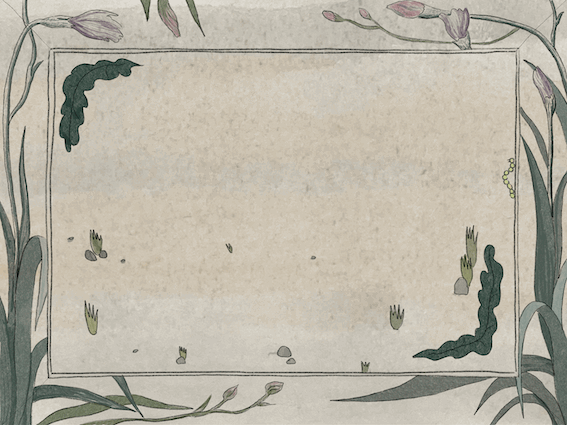
<Chochungdo (Paintings of plants and Insects)> 2021
The piece began from the image of a spider, inspired by the downward gaze on fingers weaving through silk strings of the gayageum. It centers on a plucking technique that emphasizes the viscous tension between the flesh of the fingers and the surface of the strings—where touch clings and releases. Ambient sounds were layered with field recordings from Bukchon, Seongsan, and the Han River.
The title Chochungdo (草蟲圖) refers to traditional Korean and East Asian paintings of plants and insects—intimate studies of delicate, often overlooked life forms. The music draws from this sensitivity, capturing the tactile and ephemeral quality of motion and sound.
☞youtube
Director, Concept, Music, Sound designer
Selected work sponsored by National Gugak Center
<초충도 (草蟲圖)> 2021
명주실로 만든 가야금 줄을 넘나드는 손의 모습을 내려다보며 마치 거미같다는 생각으로부터 출발한 곡이다. 줄의 면과 손가락 살이 붙었다 떨어지는 점성에 집중하여 뜯는 주법을 중심으로 만들었다. 북촌, 성산, 한강에서 수집한 자연소리를 앰비언스로 넣었다.
기획·구성·음악·사운드 | 조선아
구성·그림·스톱모션 | 장다은
영상 편집 | 김병석
제작 | 배상희
☞youtube
국립국악원 국악아티스트랩에 선정되어 제작한 작업입니다.
The piece began from the image of a spider, inspired by the downward gaze on fingers weaving through silk strings of the gayageum. It centers on a plucking technique that emphasizes the viscous tension between the flesh of the fingers and the surface of the strings—where touch clings and releases. Ambient sounds were layered with field recordings from Bukchon, Seongsan, and the Han River.
The title Chochungdo (草蟲圖) refers to traditional Korean and East Asian paintings of plants and insects—intimate studies of delicate, often overlooked life forms. The music draws from this sensitivity, capturing the tactile and ephemeral quality of motion and sound.
☞youtube
Director, Concept, Music, Sound designer
Selected work sponsored by National Gugak Center
<초충도 (草蟲圖)> 2021
명주실로 만든 가야금 줄을 넘나드는 손의 모습을 내려다보며 마치 거미같다는 생각으로부터 출발한 곡이다. 줄의 면과 손가락 살이 붙었다 떨어지는 점성에 집중하여 뜯는 주법을 중심으로 만들었다. 북촌, 성산, 한강에서 수집한 자연소리를 앰비언스로 넣었다.
기획·구성·음악·사운드 | 조선아
구성·그림·스톱모션 | 장다은
영상 편집 | 김병석
제작 | 배상희
☞youtube
국립국악원 국악아티스트랩에 선정되어 제작한 작업입니다.
